Within the past couple of weeks, coyote pups were born here in San Francisco. Whatever defensive patterns coyotes had before the pups were born have now been compounded. Especially if you have a dog, you need to know and understand them for what they are. I wrote this three years ago: what I say and how I say it can’t be improved upon, so here it is again for you. Janet
Testing/Provoking Behavior
28 Mar 2024 Leave a comment
in coyote behavior, coyote reactions to dogs, coyotes and dogs, dog reactions to coyotes, testing
Coyotes “test” in order to assess and learn about the world around them. “Testing” needs to be differentiated from “messaging”. The messaging behavior, as I’ve often said, is a clear warning, usually to dogs, to keep away or go away. It involves scary posturing, including an arched back, gaping with lips pulled back and teeth bared, tail tucked under: the message is “leave!” If you encounter this behavior, the best thing to do is walk away and keep walking away. That’s what the coyote wants, so you might as well do it.
On the other hand, curious coyotes may *test* or *assess* how a dog will react to them which is not a demand to immediately move away — though this is what you should do practically to discourage the behavior. A coyote may test or assess a dog by approaching with a little bouncy gait or play-bows and try to interact, touch, or nip the dog’s tail. Some people have mistaken this for an invitation to play, whereas other dog owners have been terrified of any coyote approaching their dog. Although it does not look unfriendly, it needs to be discouraged. This is testing behavior and not play: a dog should be pulled away from this situation and walked away from the coyote. And here is the video, taken long ago in the San Francisco fog, which shows this coyote behavior towards, in this case, a disinterested dog who doesn’t react at all to the coyote. Few dogs will behave like this dog. Most dogs will lunge at and bark at the coyote.
A variation of this testing behavior might involve a bit of a dare or provocation — messaging displays are not involved. Your reaction should be the same: leash your dog and move away from the coyote showing him you aren’t interested in interacting. I’ll describe this here:
Coyotes watch in order to get to know the world. As they do so, they assess and judge situations and individuals of interest to them, in this case dogs. Watching informs them about what every animal is capable of and how their own safety might be affected by these capabilities. After watching for some time — maybe even weeks on a regular basis — a coyote might summon up enough courage to “test” or even “provoke” a reaction in a dog: it’s a variation on the testing behavior I outlined above.
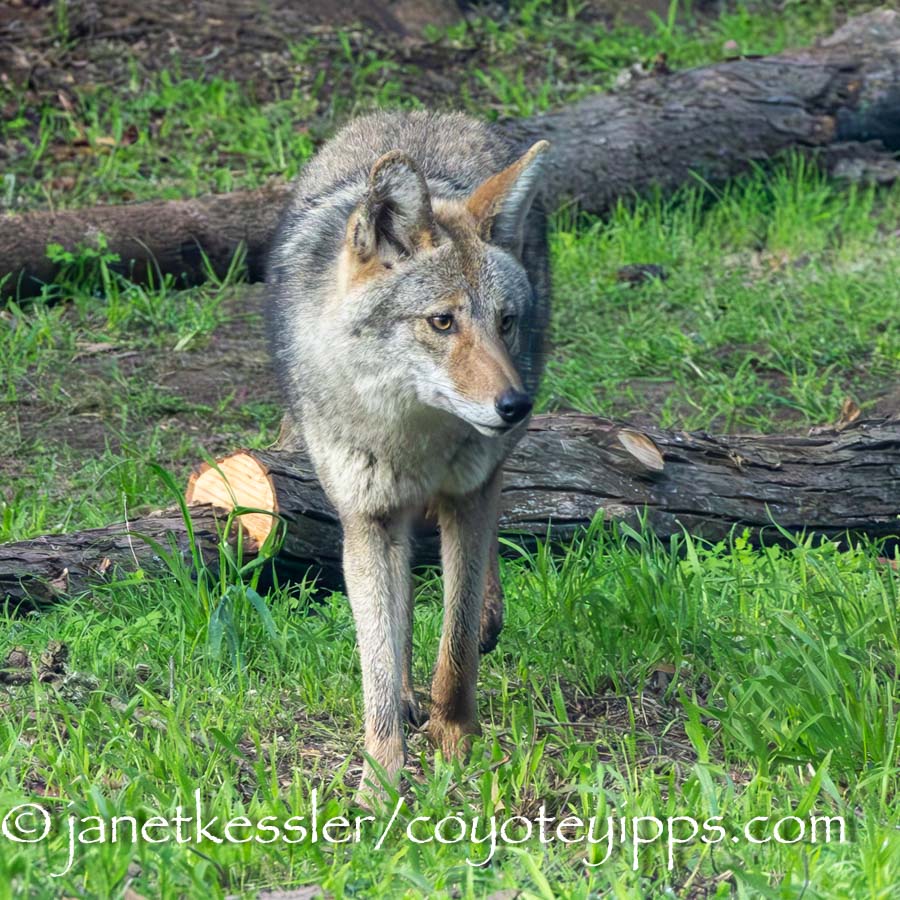
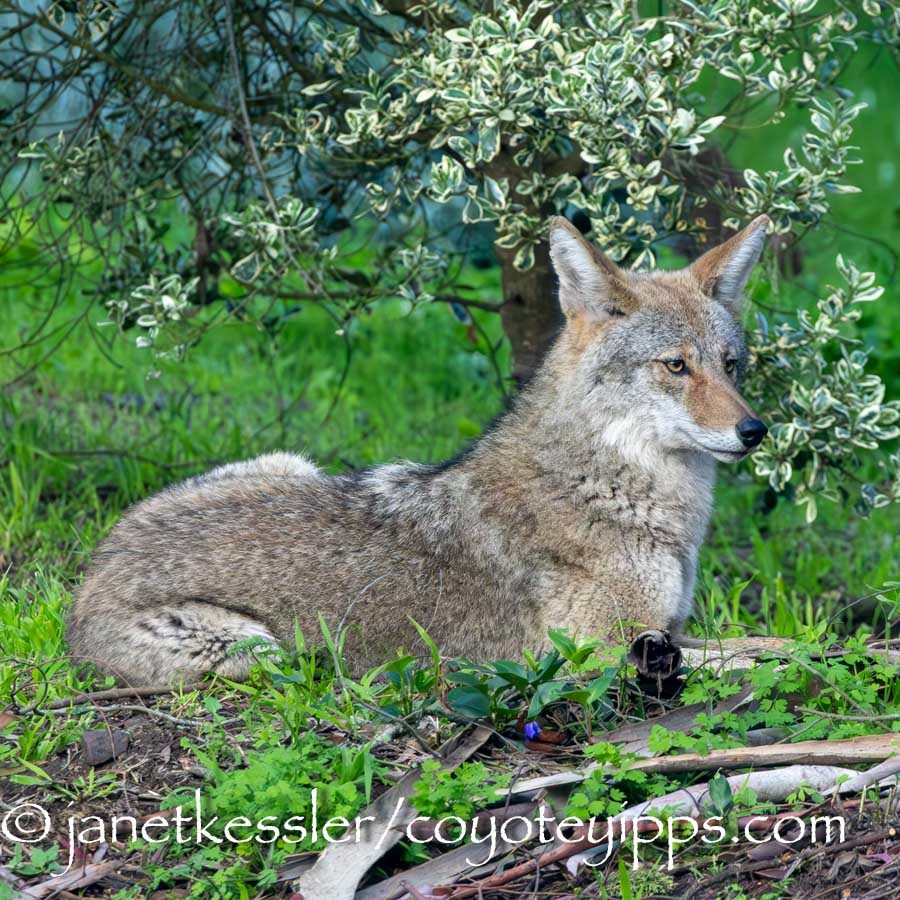
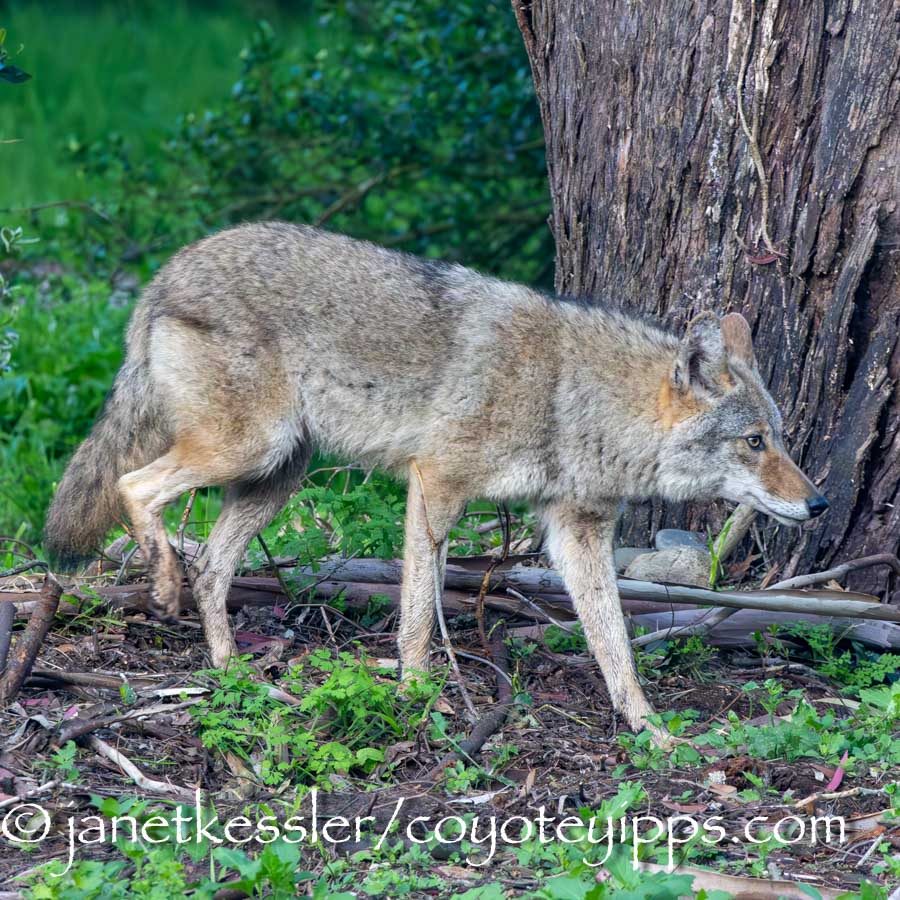
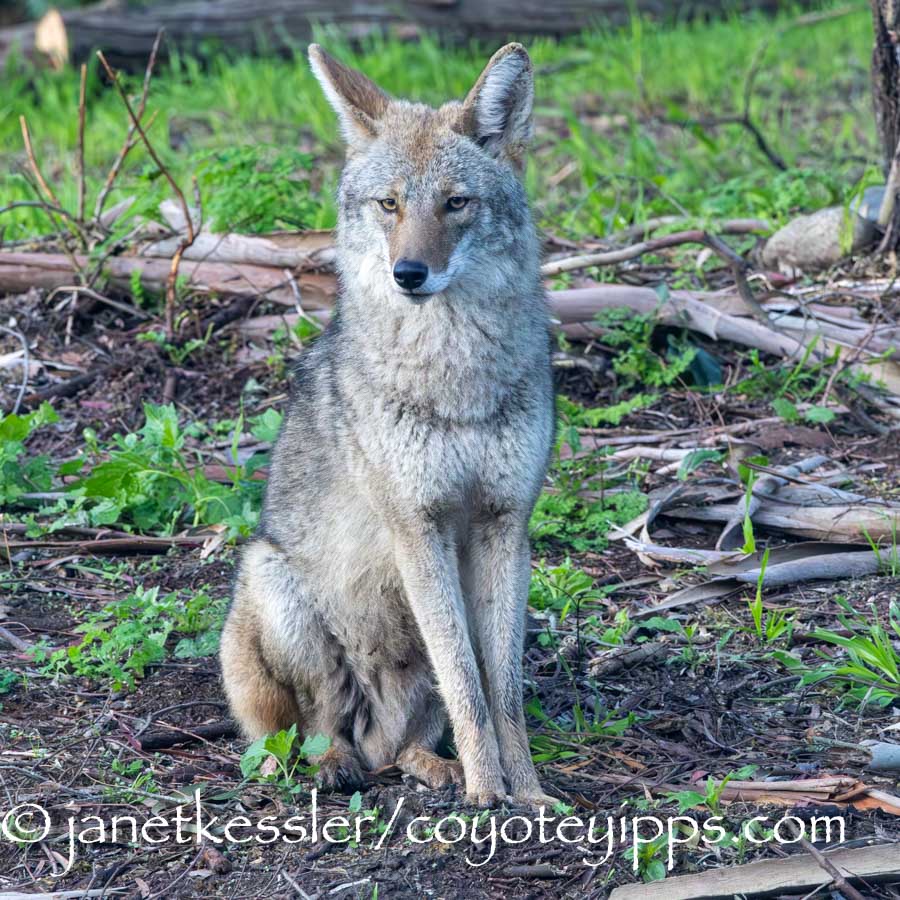
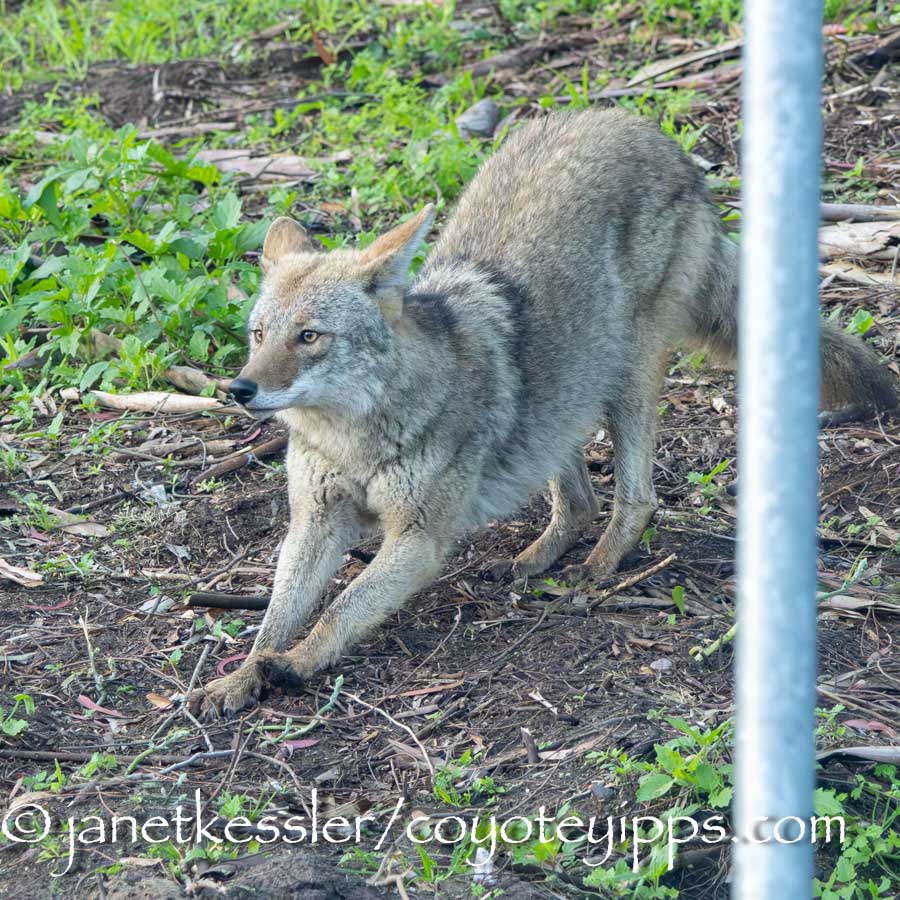
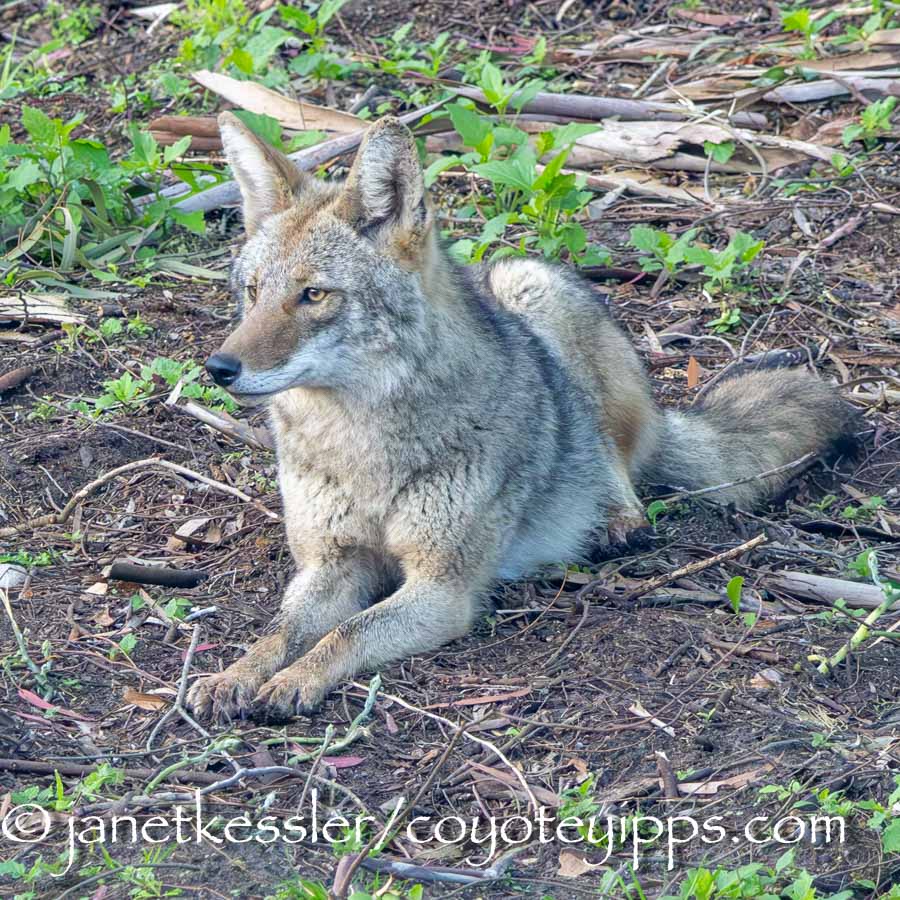
One of the coyotes I watch has, for the last little while, stopped and fascinatingly watched a particular dog and his owner playing fetch on a large grassy field in a park. Over time, the coyote has come to know this dog’s capabilities and has now *graduated* to a mode where he either wants to *test* the situation or even *provoke* the dog into reacting to him. It’s not aggressive but it stirs things up a bit because it is an encounter that causes a response or retort. What is the coyote doing? First, he wants the dog to know he’s around and that this is his — the coyote’s — home. After all, the dog appears daily for less than an hour, whereas the coyote lives there.
It’s important to remember that only one coyote nuclear family occupies any one territory and all other coyotes are kept out. I’m sure this coyote exclusivity affects their feelings towards dogs. The coyote does this by entering into the dog’s field of vision and looking on or pretending to sniff something in the area, coming closer if the dog doesn’t react. To some, this may look like *play* and in fact it does border on play in that it’s fairly benign. The coyote will engage this way only only for a moment — just long enough to prove to himself that he’s the smarter and quicker and the more clever of the two. In other instances, I’ve seen the coyote swipe the dog’s ball and run off with it.
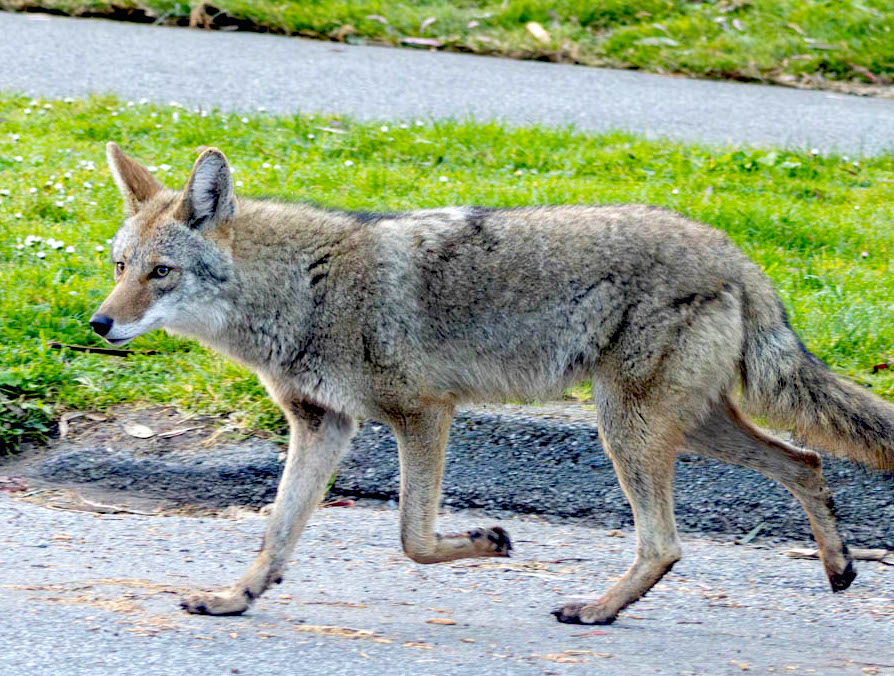
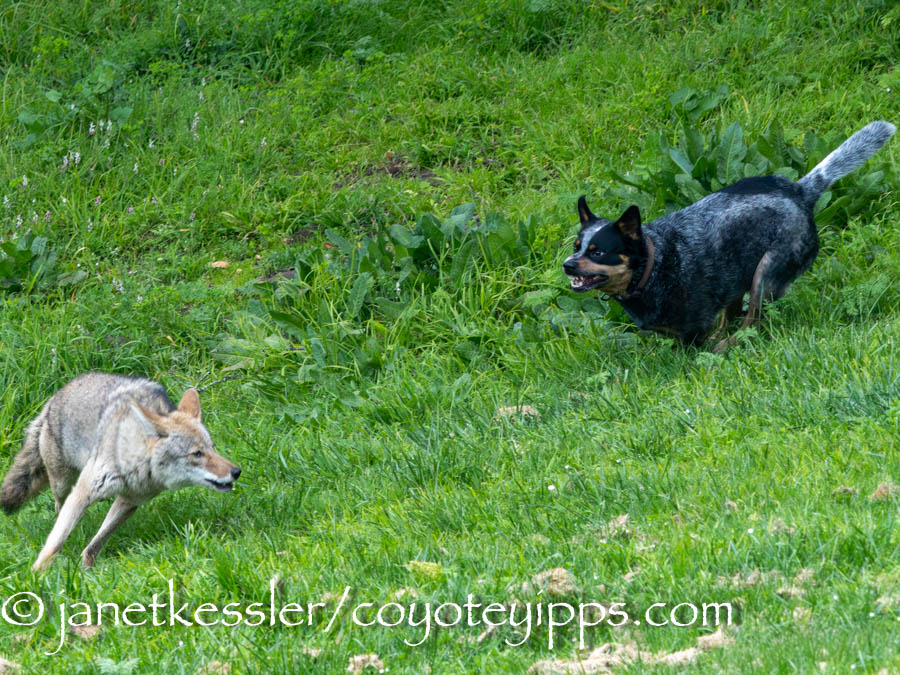
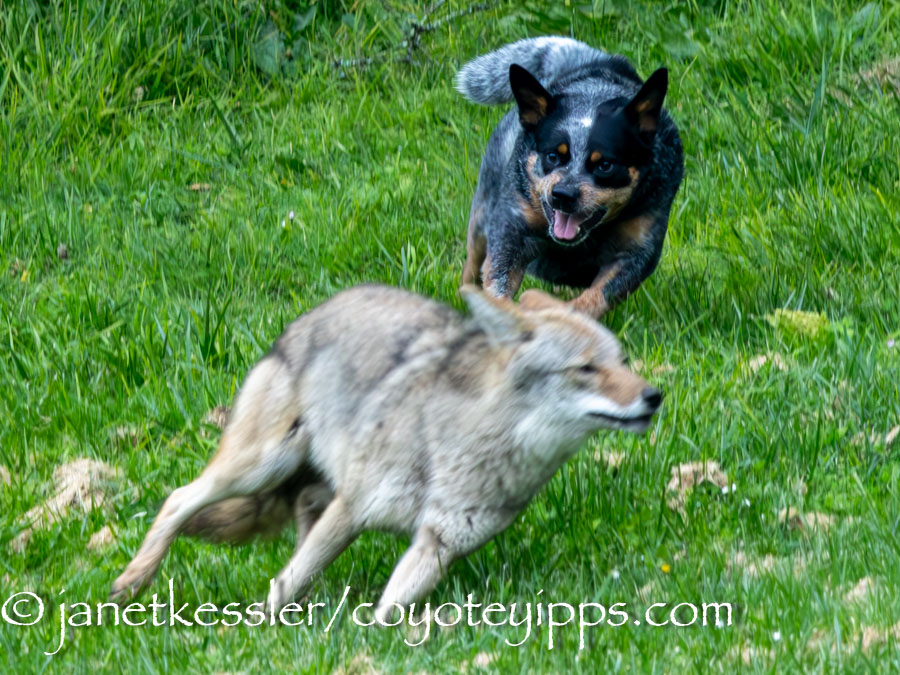


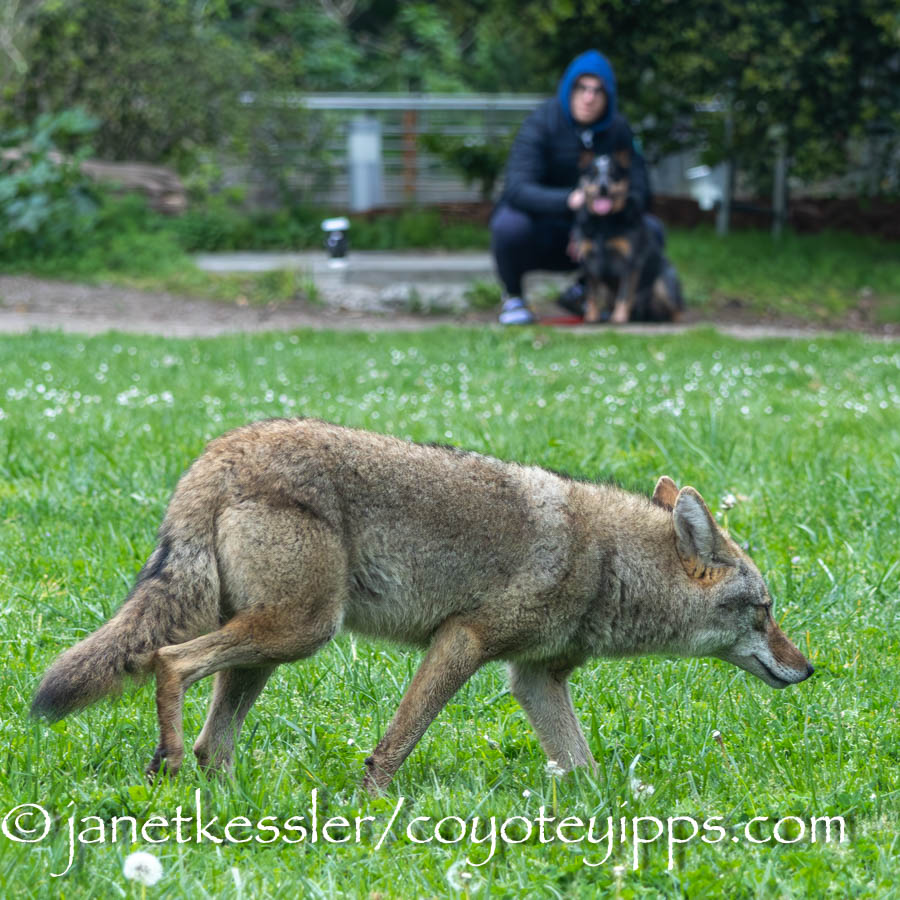
So the coyote heads towards the dog slowly. He pretends to do other things, including sniffing the ground. When the dog becomes aware of the coyote, the dog gives chase. The coyote runs off, just fast enough to keep out of reach of the dog, letting that dog get close enough so that he feels he might catch the coyote, even circling back so that the dog will continue. This, of course, only goes on for a minute before everyone yells at the dog owner to please leash his dog, which he does. That ends the interaction, and maybe in a week or so, it will happen again.
Below are photos of a coyote ducking and then crouching low in the ground to keep from being seen by a dog — this is their normal reaction to active dogs. Testing is reserved for dogs that they think pose no threat to them.
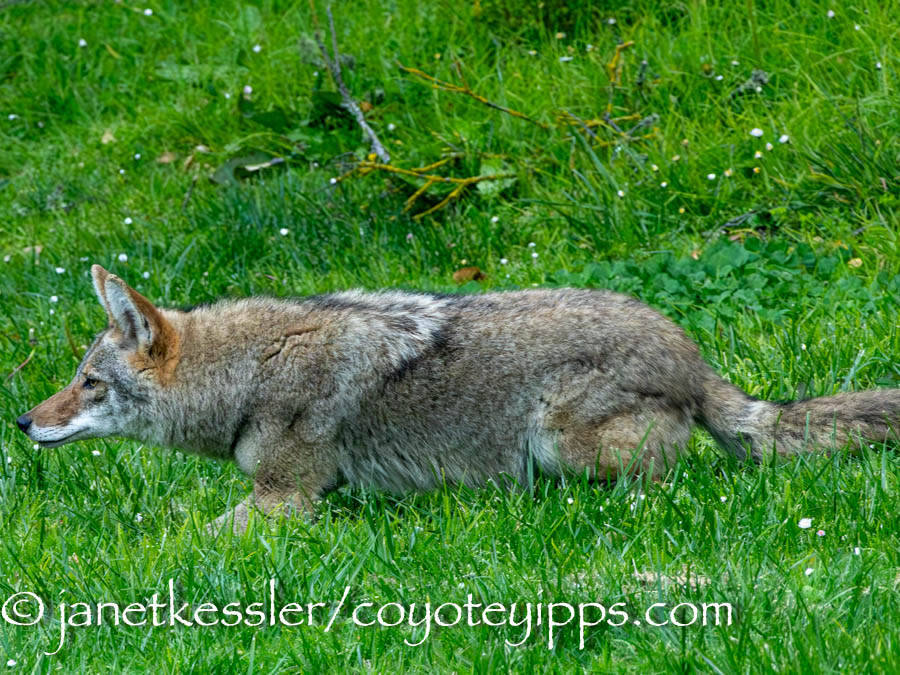
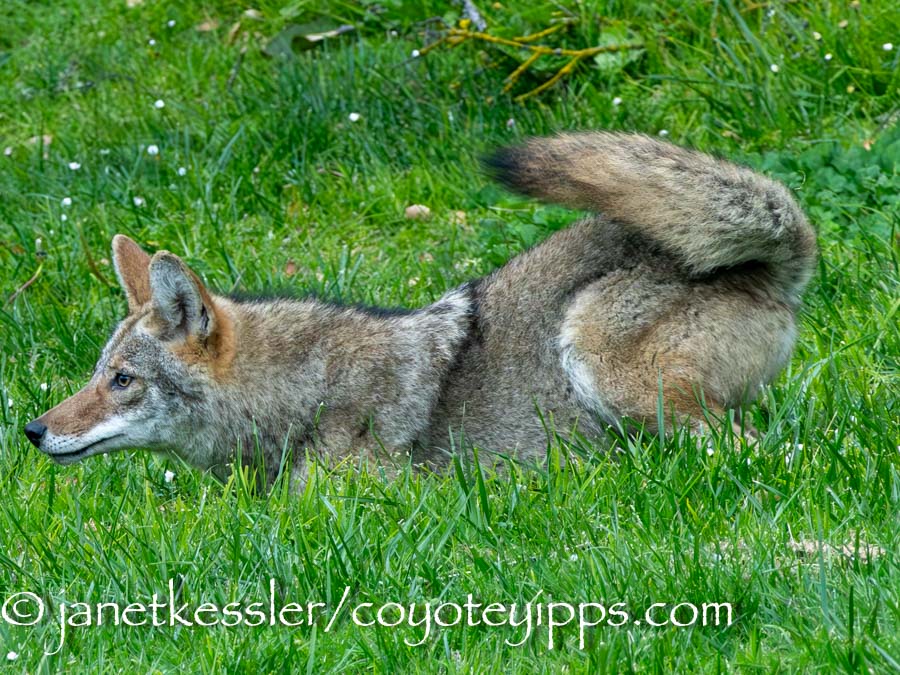
I myself, and several other people I’ve spoken to, have encountered a similar type of behavior towards human. In my case, it occurred because the coyote noticed I was focused on him: he wanted to asses what my intentions were: https://coyoteyipps.com/2023/11/03/testing-feints-and-zoomies/
© All information and photos in my postings come from my own original and first-hand observations and documentation work which I am happy to share, with permission and with properly displayed credit: ©janetkessler/coyoteyipps.com.
Mom Calling, No Answer
22 Mar 2024 Leave a comment
in coyote behavior, mating season and wandering, vocalization
It was dark, so I couldn’t see anything, but I heard the vocalization loud and clear: a coyote was calling out to someone and there was no response, a snippet of which I’ve embedded here. I know the voice, and when I got home, by lightening the video, I was able to confirm visually that this was Mom.
Two weeks ago, Mom and her family left her usual hangout area in this section of her territory where I was now hearing her calling. Last year she also had moved in order to have her pups in a safer area. Note that this is still within her 2.5 square mile territory, it’s just a different hub of that territory. The wooded area she left here has been continuously cleared by the San Francisco Park Department irregardless of the habitat needs of our wildlife, in particular coyotes. What appears to matter to them is *what they think should live here*: i.e., native plants. The problem being that this area was all sand dunes long ago, and the few native plants that grew here were small desert type plants that provide no real habitat protection, especially from the many off-leash dogs who like chasing and antagonizing the coyotes. Dogs are an invasive, non-native species for which the coyotes need thicker cover for protection than what native species can offer. The sheer number of dogs in the city is overwhelming. The coyotes used to use the thick, entangled undergrowth to hide in. I went over to the area being cleared: it’s mostly hidden from human view by the few trees they’ve left up as a sort of curtain. All that’s left is dead wood: so this is probably the reason for moving. Note that “mating for life” I’m finding to be less and less true these days. This alpha female is on her fourth mate.
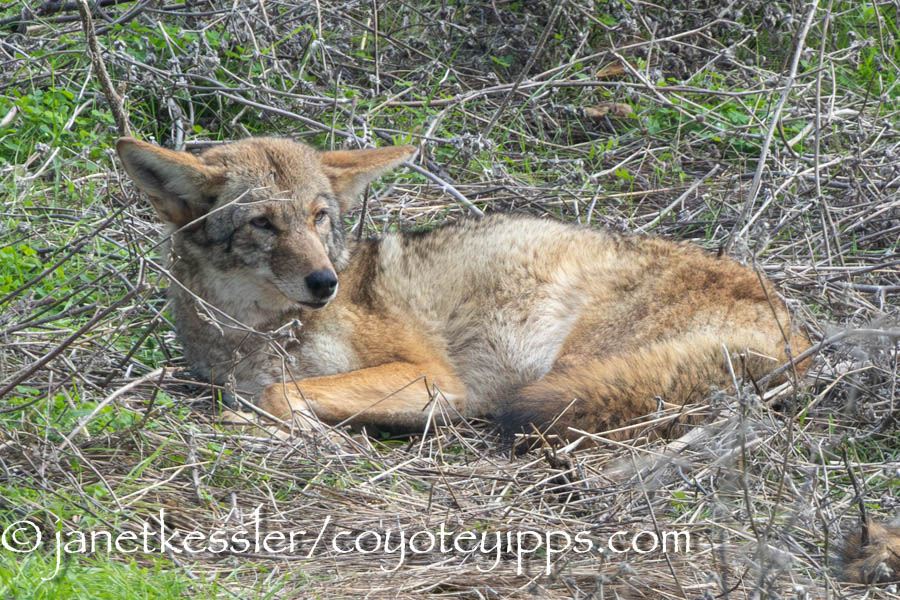
So Mom moved her family, along with her new mate and two yearlings. One *pup* — not quite a year old yet — can still occasionally be seen here alone: I don’t know if he chose to remain behind or if he was *assigned* to remain here: both ideas have occurred to me as possibilities, but there’s no way for me to know this. This youngster is a relatively large male, and I can imagine that Mom’s new mate might not want him around: I say this because of the bite marks I’ve seen on his snout the last few times I’ve seen him. Coyotes discipline, convey dislike, AND show dominance by grabbing another’s snout, sometimes quite hard.
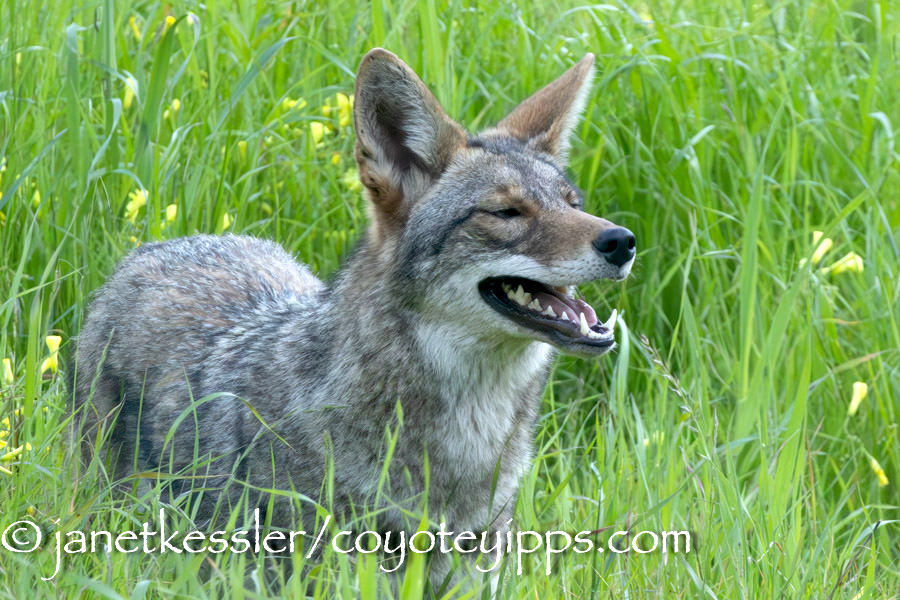
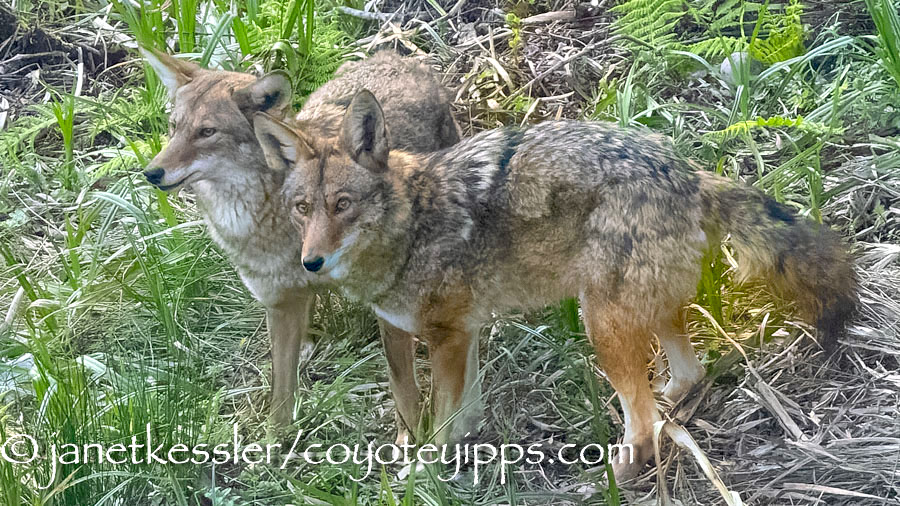
Mom herself went through a family makeover earlier this year. First of all, her mate from over the past several years left her. Well . . . did he leave her or was he driven out? Again, I don’t know the answer, but either way, I found him happily paired up with another female on her territory about a mile away: it was such a surprise because coyotes have famous reputations for mating for life. It might be interesting for all to know that, as far as I have seen, it’s the females who choose (or inherit) their territories, and who also choose their specific den sites. Did he leave of his own volition, or was he driven out by her? I think the former, but I can’t prove it.
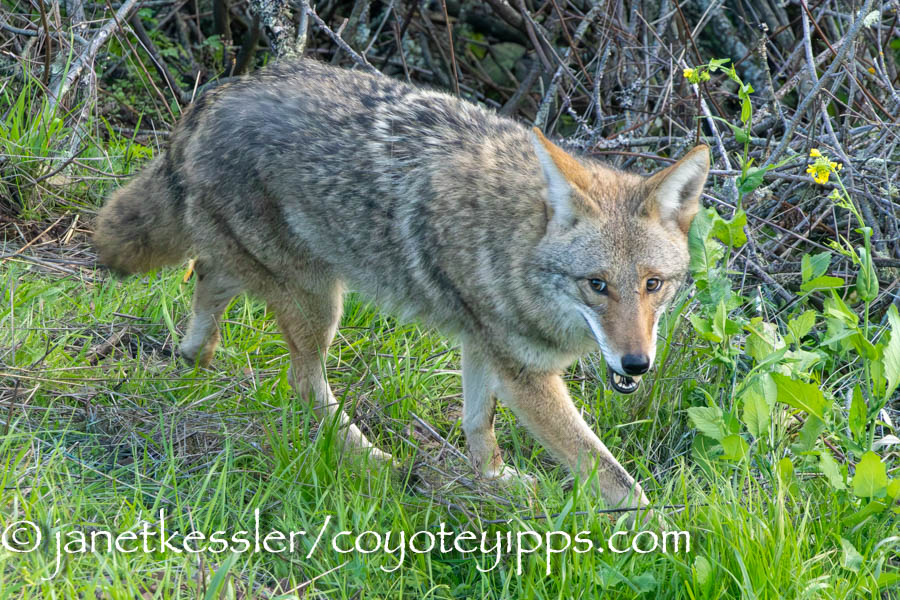

Then, last night, Mom was back here, definitely calling someone from her family. The calling went on for ten straight minutes: I’ve cut out a short section of it for you to hear. Who was she calling to? It could have been the large male pup who has been hanging out here alone, only he was not around last night. But, might she have been calling her old mate? Maybe his departure had not been a fait accompli? Maybe she was hoping he hadn’t left? Then again, maybe she was looking for her new mate who might have wandered off? I haven’t seen any of them since they left except 11-month old son. And then a few days ago I heard this definite calling out with no response on March 14th.
Raptor Resource Project: Guest Blog
14 Mar 2024 Leave a comment
in coyote behavior, Raptor Resource Project, vocalization
More Razor Sharp Awareness and Concern: Lapis and her Brother
25 Feb 2024 4 Comments
in altruism, awareness, care for each other, siblings
Lapis has been limping. It’s not a hard limp, but a definite limp. It must hurt her because she stops her walking and lies down apparently to relieve the pain.
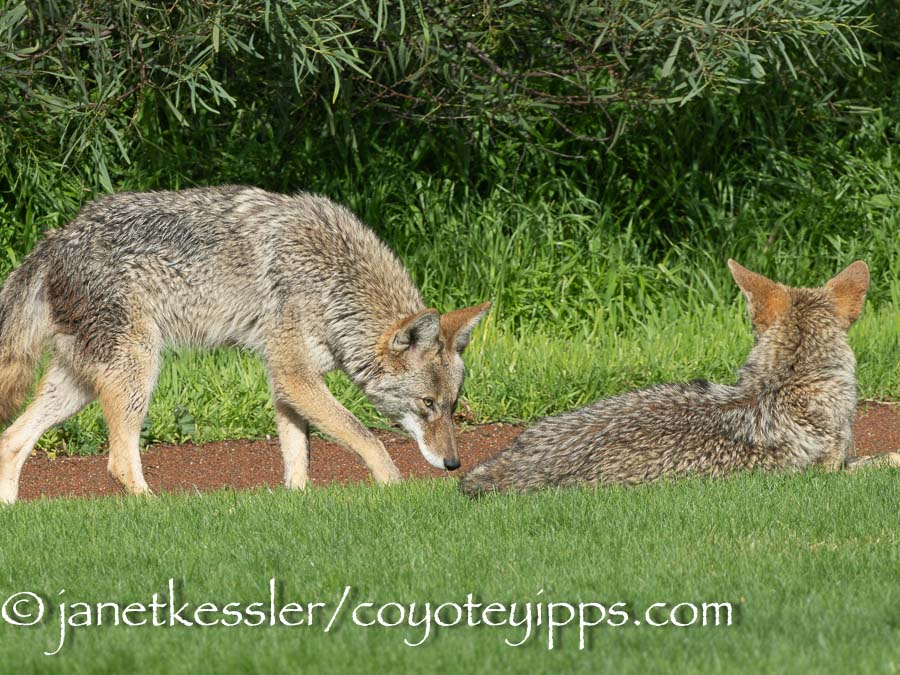
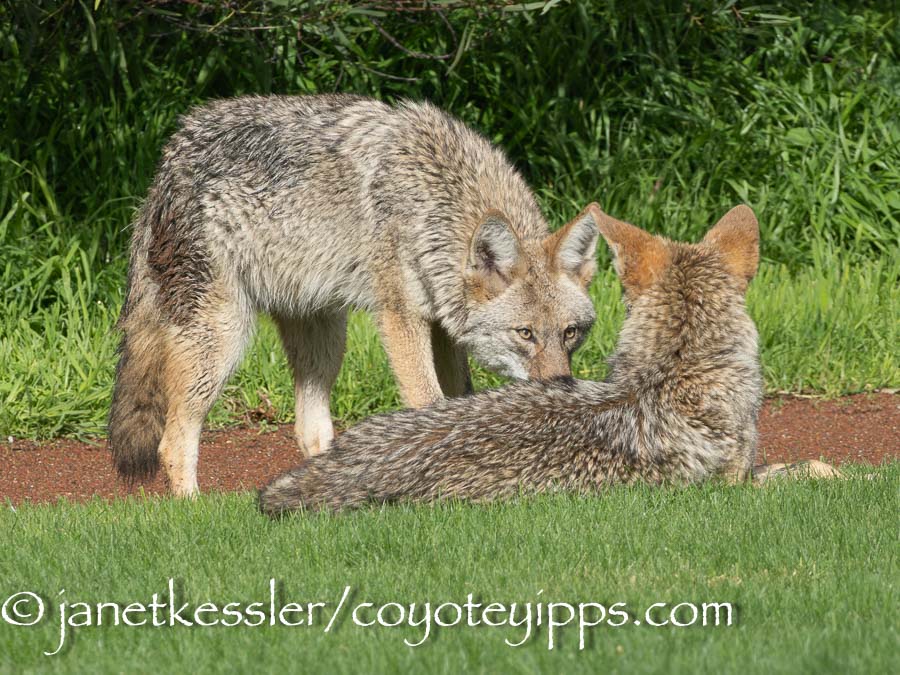
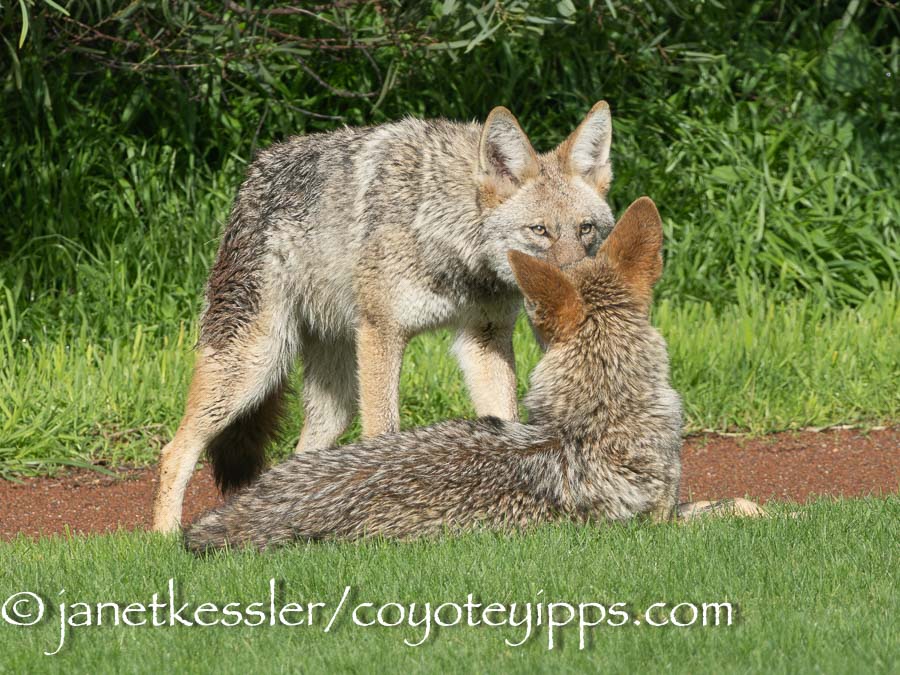
Brother then comes by and can sense why she’s lying exactly this way. He comes by, keenly focusing on her eyes — eye-to-eye communication, caringly reading every nuance of her reaction to himself as he gets closer. He’s looking to see if she might not want him to come closer. I know she trusts him because he has earned that trust.
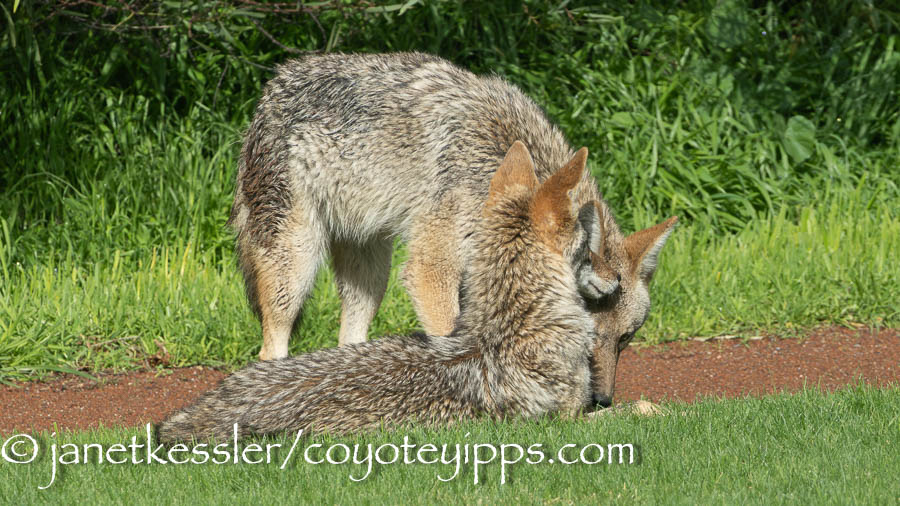
He is always attuned and responsive to her, whether when she’s ready for a chase or just wants to sit. He knows she has a painful leg. Fascinatingly, and I’ve seen this before a number of times, he SNIFFS her foreleg, not just to find out more about it, but also to let her know that he knows about it and that he is concerned. She trustingly watches his very careful and deliberate approach. I myself don’t know if pheromone markers of any type are produced by such an injury, or if simply the heat from the injury is what he detects, but he is able to detect what he needs to. I’ve seen this same type of awareness and detection several times: 1) In this photo, a female found out more about her mate’s injury by smelling it, and then prodded him to move out of the area where dogs might continue to chase him (see photo below from SPCAHSU Peninsula talk]; and here a sibling sniffed to find out about her brother’s injury and then tried channeling his movement to safer places: Cat prodding Sparks.
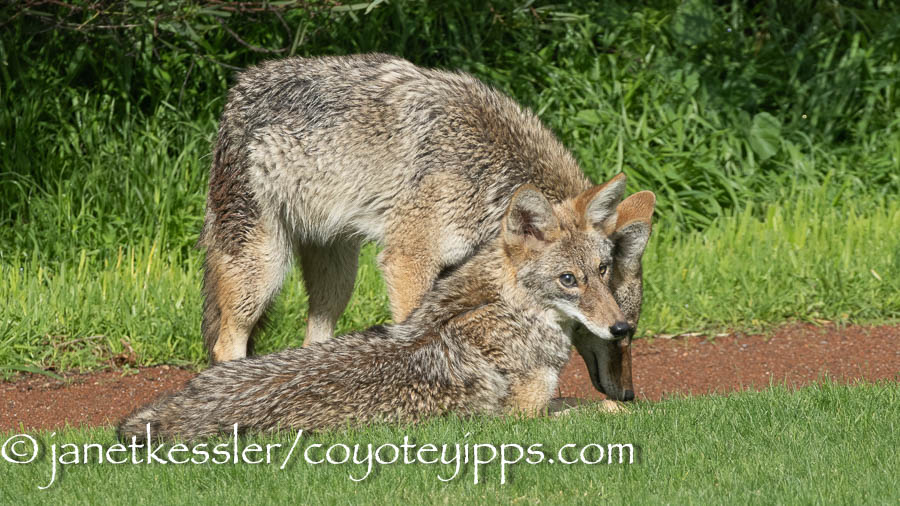
When Brother appears, he doesn’t poke or push, he simply sniffs and then slowly lowers himself to the ground next to her to lie by her side, as though he wanted to be a comforting presence. I was enthralled watching this: mostly the subtle eye to eye contact, keen mutual awareness, and caring responsiveness.
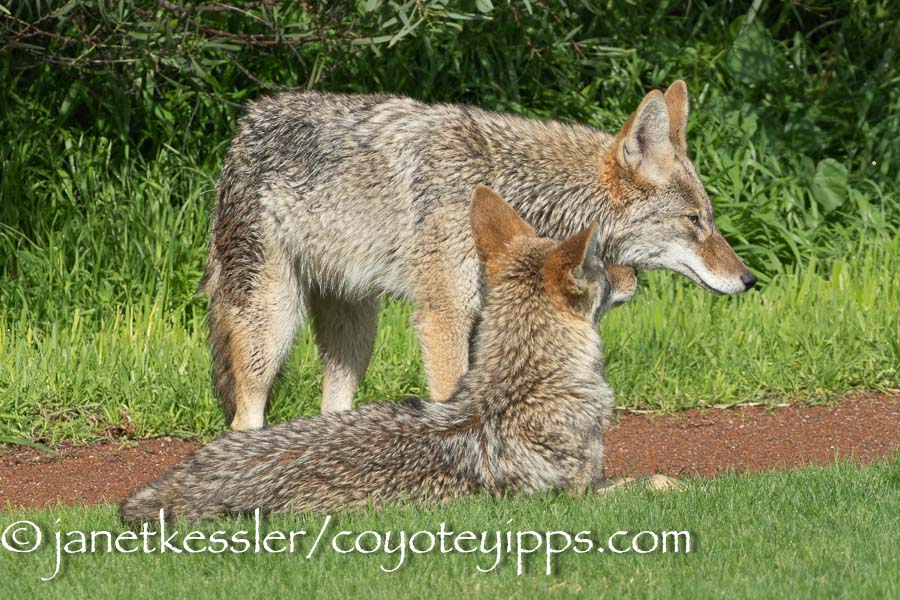
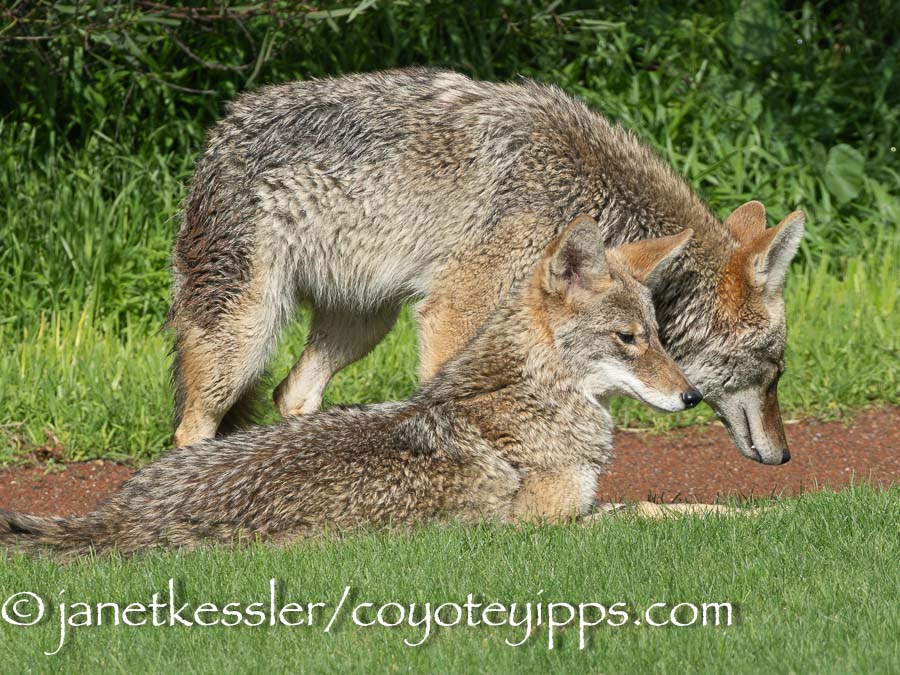
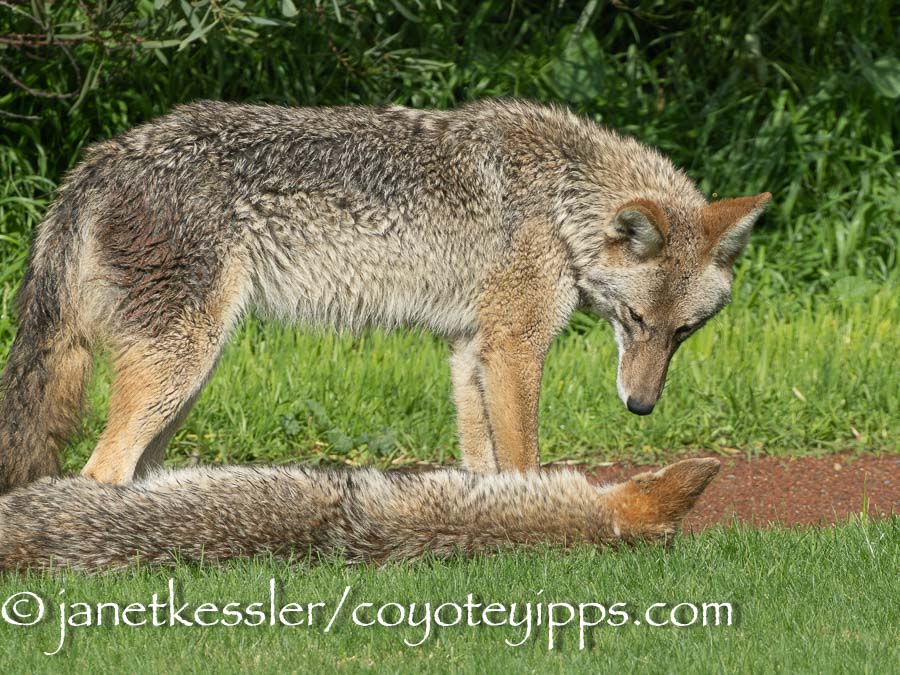
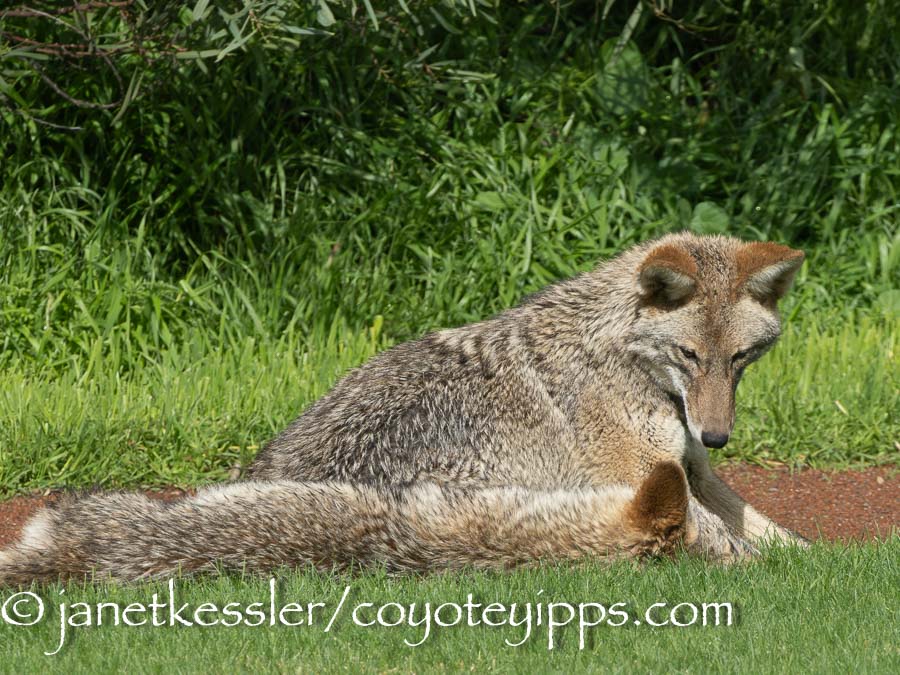
These two are highly intune, almost telepathically communicative with each other. Mostly, they are understanding and empathetic and warm towards each other in a way I think most of us humans are not aware of, or even, often, capable among ourselves unless it’s a very intimate relationship. When he looks at her, you can FEEL this understanding of her.
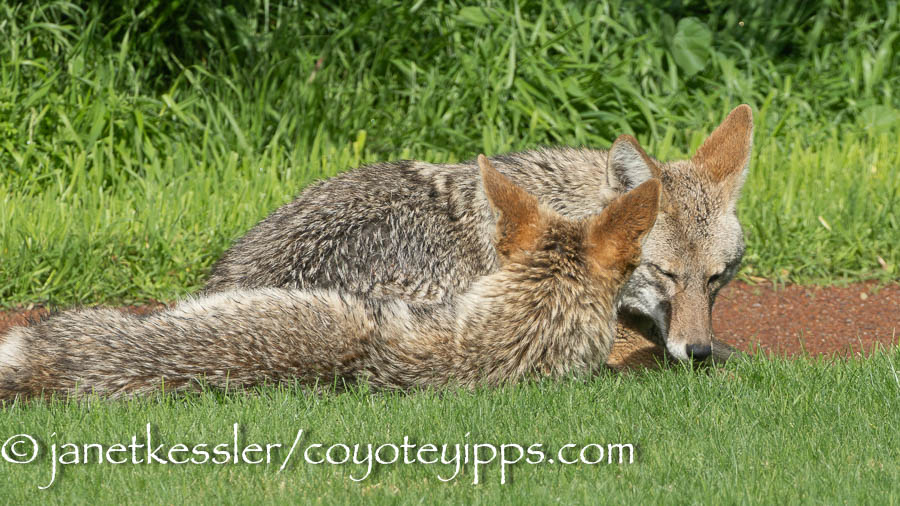
When he plays with her, he only plays as roughly as she plays. If you have a dog, you’ll know what I mean: my dog would play tug of war with me, but always only as roughly as I would. If I pulled gently, she would only use that same force to play with me.If I tugged much more roughly, she exerted that same force, in other words, playing at MY level of capability. I’ve seen this brother coyote play with his much larger and more developed brother, and that is a totally different, rough and tumble, competitive and even forceful interaction. In fact, this caring brother in the end always submits to that roughhouse brother in order to stop the rough play.
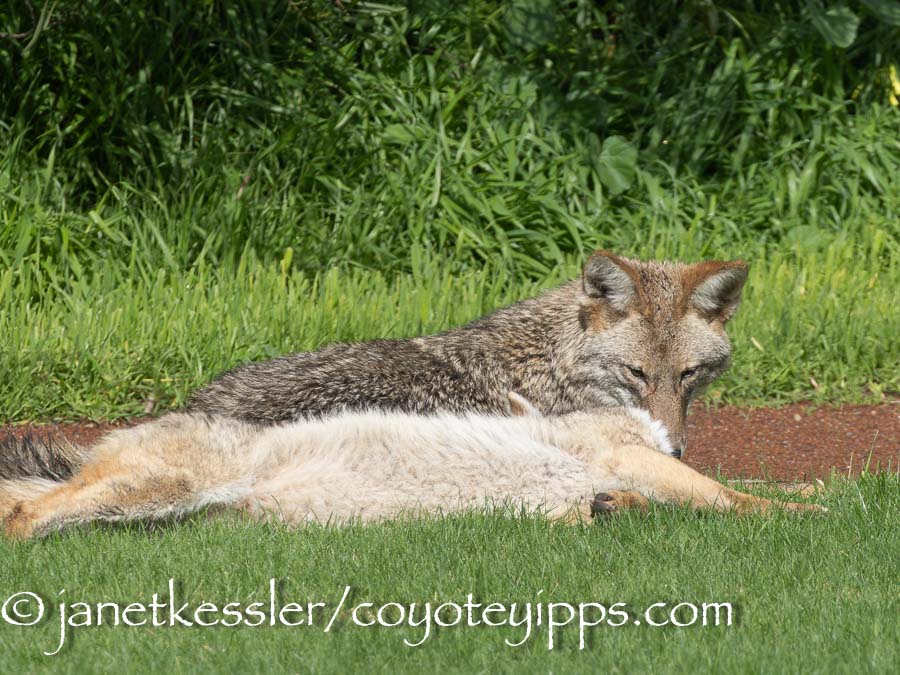
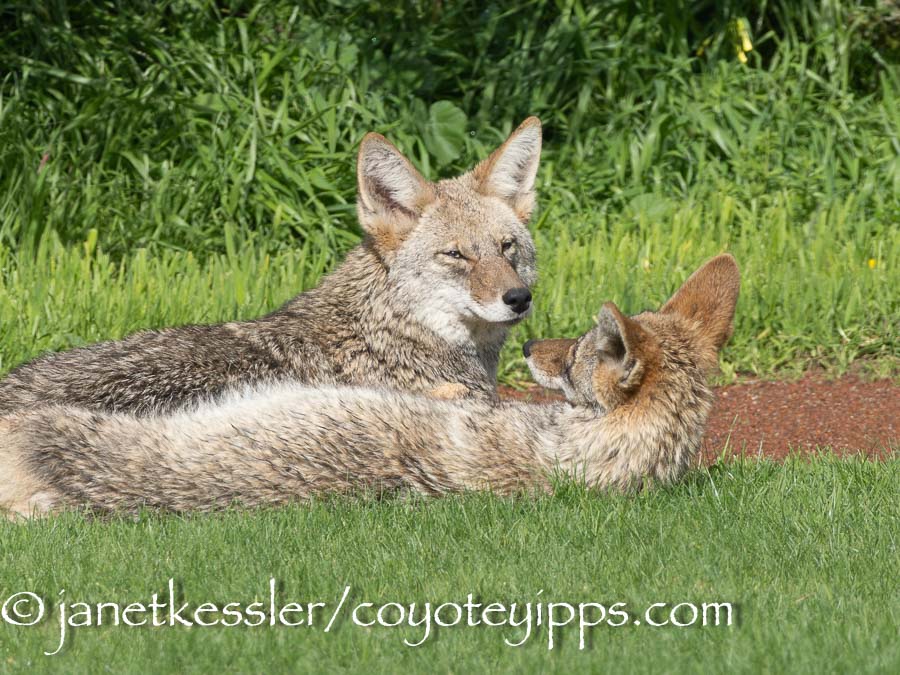
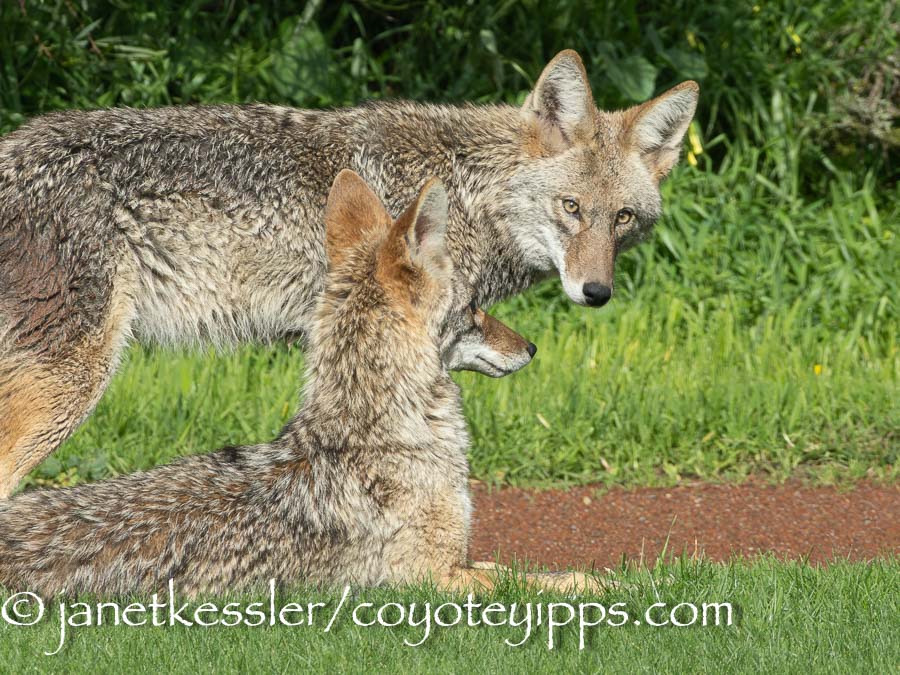
2-5
Razor-Sharp Awareness and Concern: More on Lapis
16 Feb 2024 4 Comments
in awareness, communication, Injuries
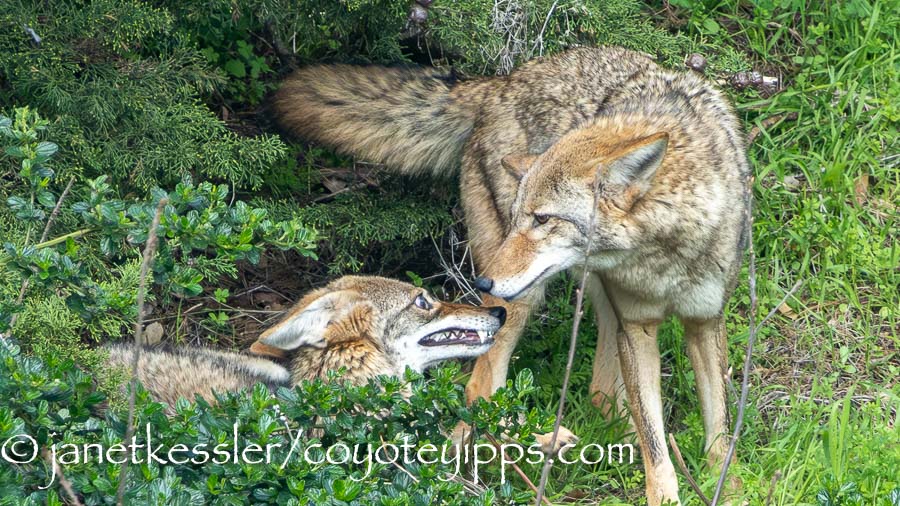
Recall that Lapis — the 10-month-old female who I’ve written about — has an eye condition which is either congenital, or possibly an early injury. According to the vet, her eye isn’t hurting her or she would be squinting it. But we don’t know if she can actually see out of it, though she appears to because she doesn’t turn her head to favor her *good* eye. We also don’t know if the eye itself, or the socket around it might be more sensitive than normal to the touch in any way.

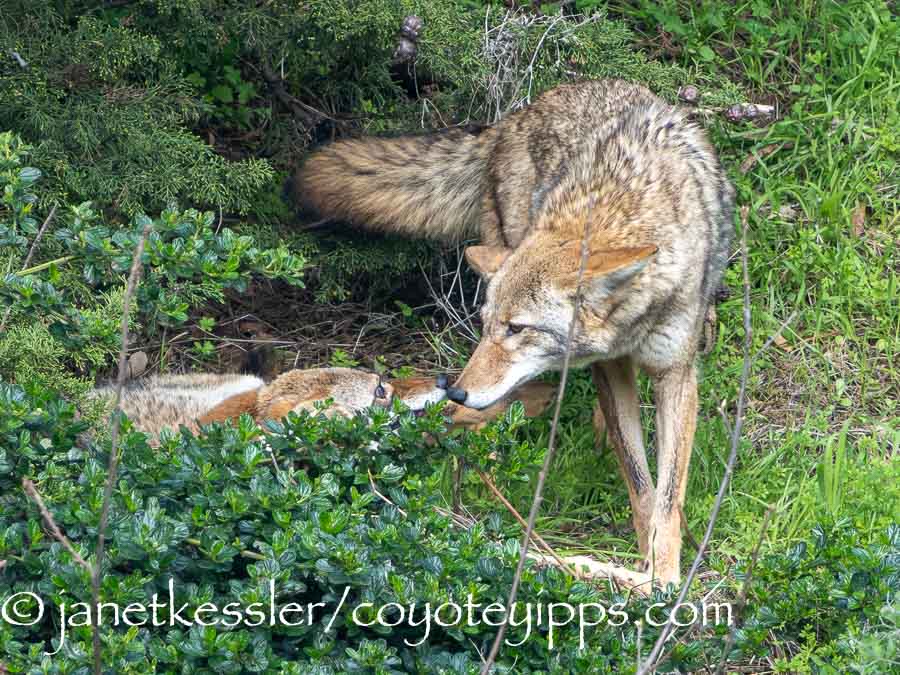

Mom stares into her daughter’s compromised eye trying to figure out why it’s odd.
These photos above show her mother’s keen awareness of that eye. In other words, to us the eye stands out visually, and it does the same for her mother. This “staring into her eye” lasted many moments, probably trying to figure out what might be wrong, or figuring out if there is a way she might fix it. So for example, if there was a foreign object in that eye, Mom might be able to physically pull it out, but, of course, this is not the case here.
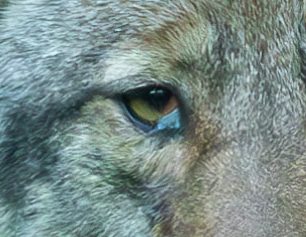
And here, to the right, is a photo of such an object lodged in another youngster’s eye: mostly goop around something the size of short fur. This is not Lapis’ situation. This is a coyote youngster from an entirely different family, just to show that grit and objects sometimes end up in eyes..
With Mom’s intense gaze, along with her body movements indicating she was about to approach that eye, Lapis pulls back her lip and bares her teeth with a snarl: a clear message that this kind of intrusion, even from her mother, would not be welcomed: “Please DON’T!” At the same time, Lapis emits a few high-pitched squeals of pain at her mother: “Please STOP!” emphasizing that anything the mother might try is going to hurt her.
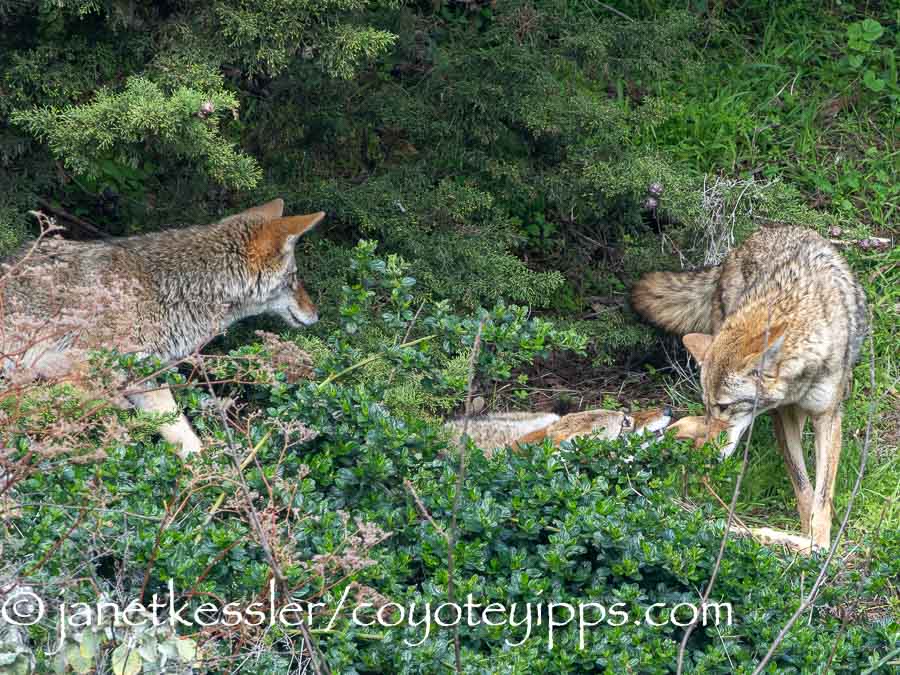
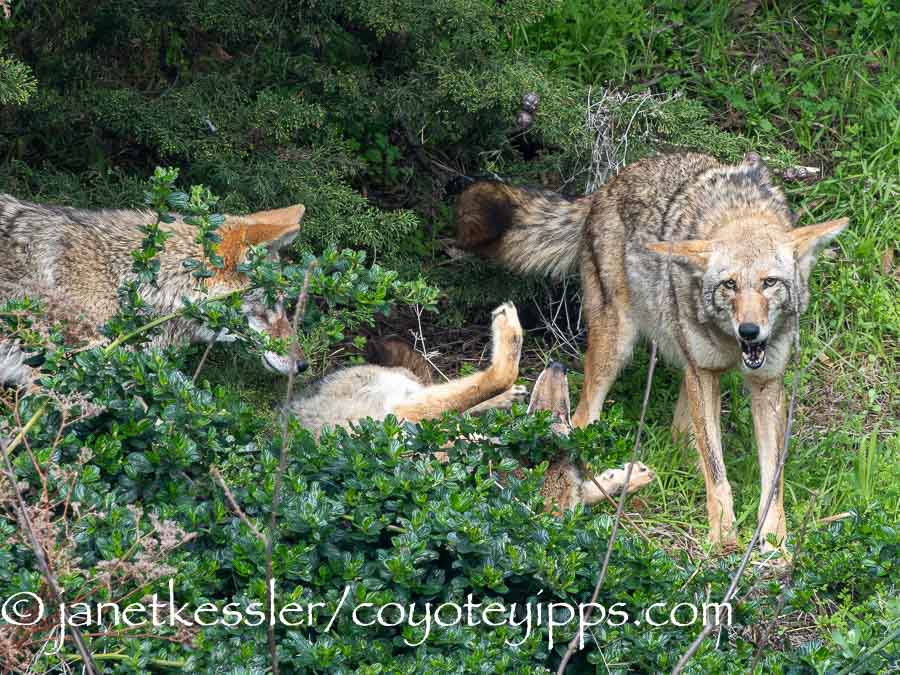
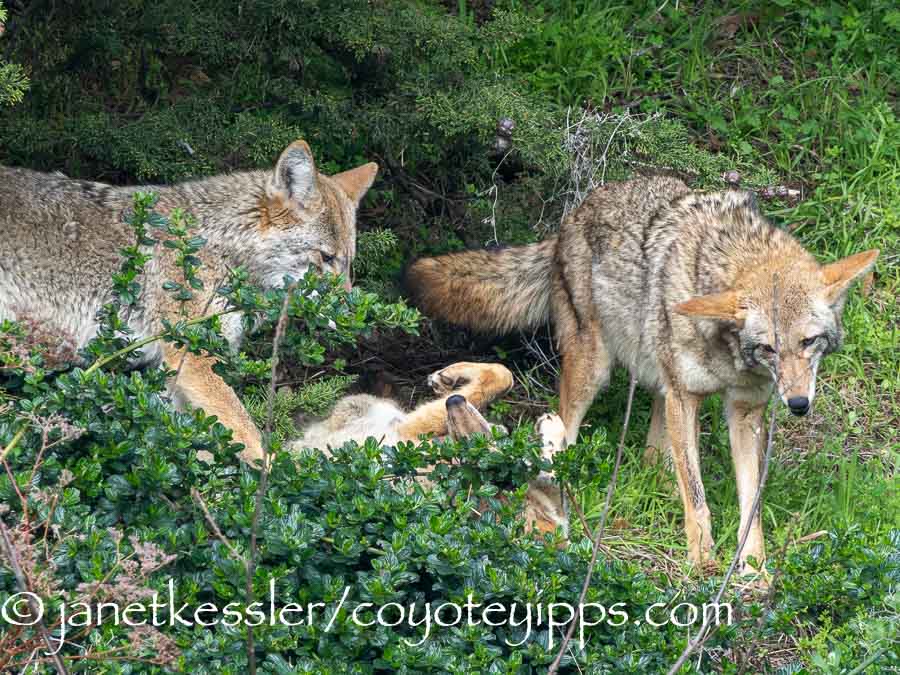
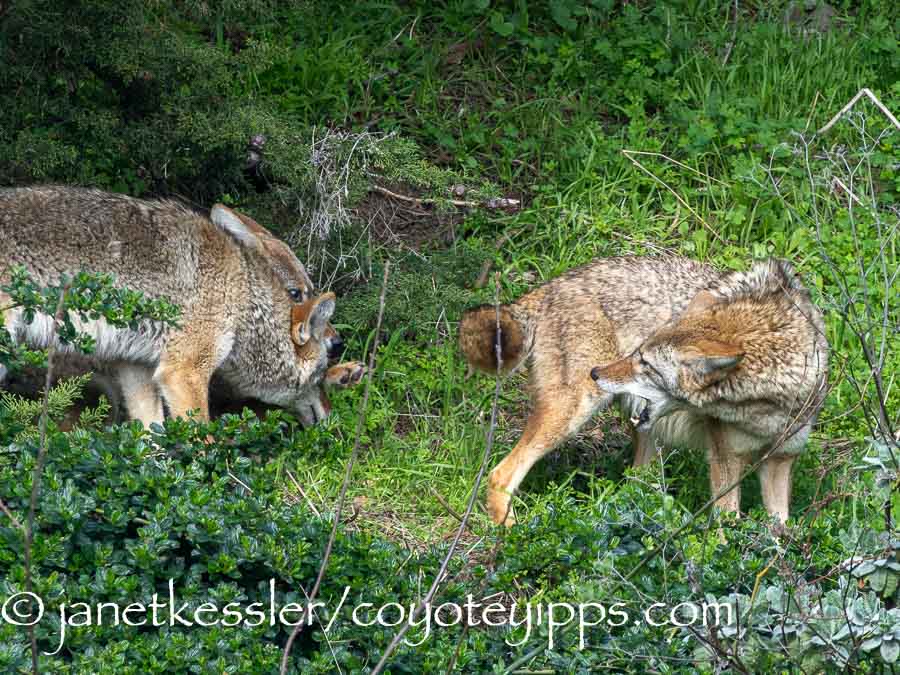
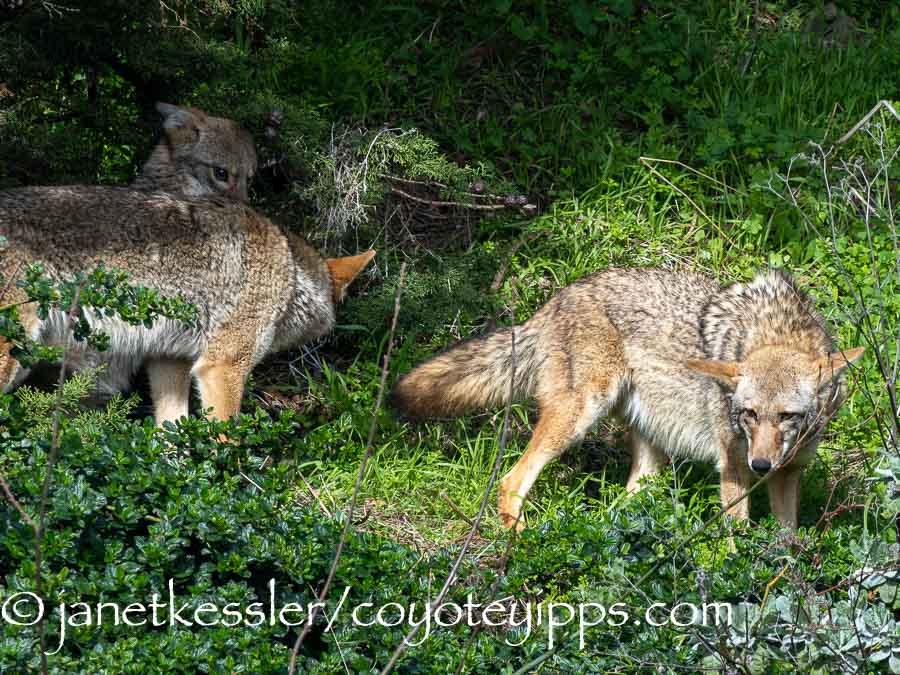

Brother comes to sister’s rescue: sensitively and intelligently!
After Lapis emitted those short squeals of pain, BFF brother comes over to his sister’s defense. He seems to know she doesn’t want to be poked at, even by a well-meaning mother. In this family, he has spent the most time with his sister: he and his sister play constantly and I’ve watch them achieve a very nuanced and keen awareness and understanding of, and communication with, each other, and I’m sure it’s even deeper than anything I can see. So he is more intimately aware, even than his own mother, of what his sister’s feelings and needs are: I would say that he has a handle on her very essence.
Of course he has to be very diplomatic and careful how he “tells” mom to back off: this is hard, because naturally Mom is top dog here and everyone falls in line under her. Since she is the dominant one and he has to submit to her, he messages Mom gently to move away by offering himself to be groomed instead. What a brilliant move!
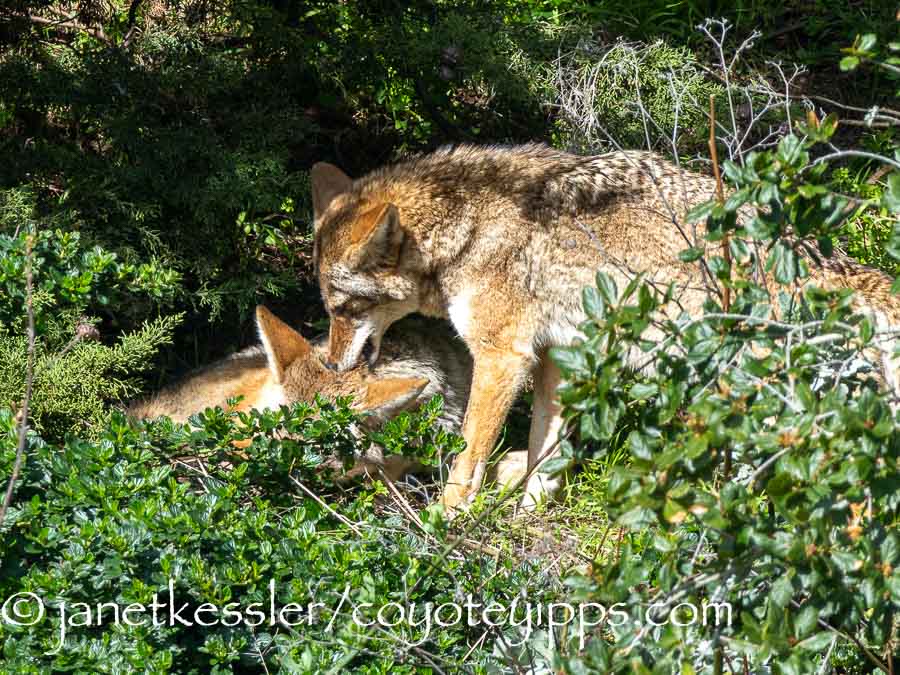

Above: brother inserts himself in front of Mom to be groomed, and she obliges.
Well, that solved the problem! Sister moves off, and brother becomes the object of Mom’s attention! (2-8)
Coyote Communication: Potent and Effective
28 Jan 2024 2 Comments
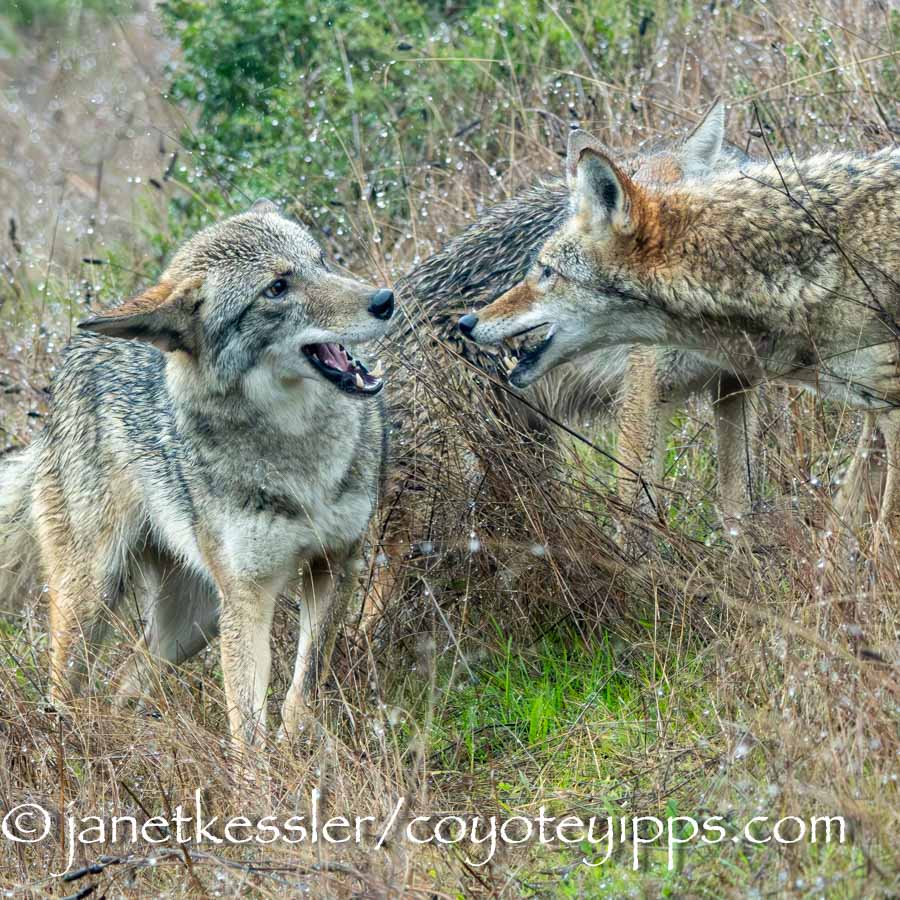
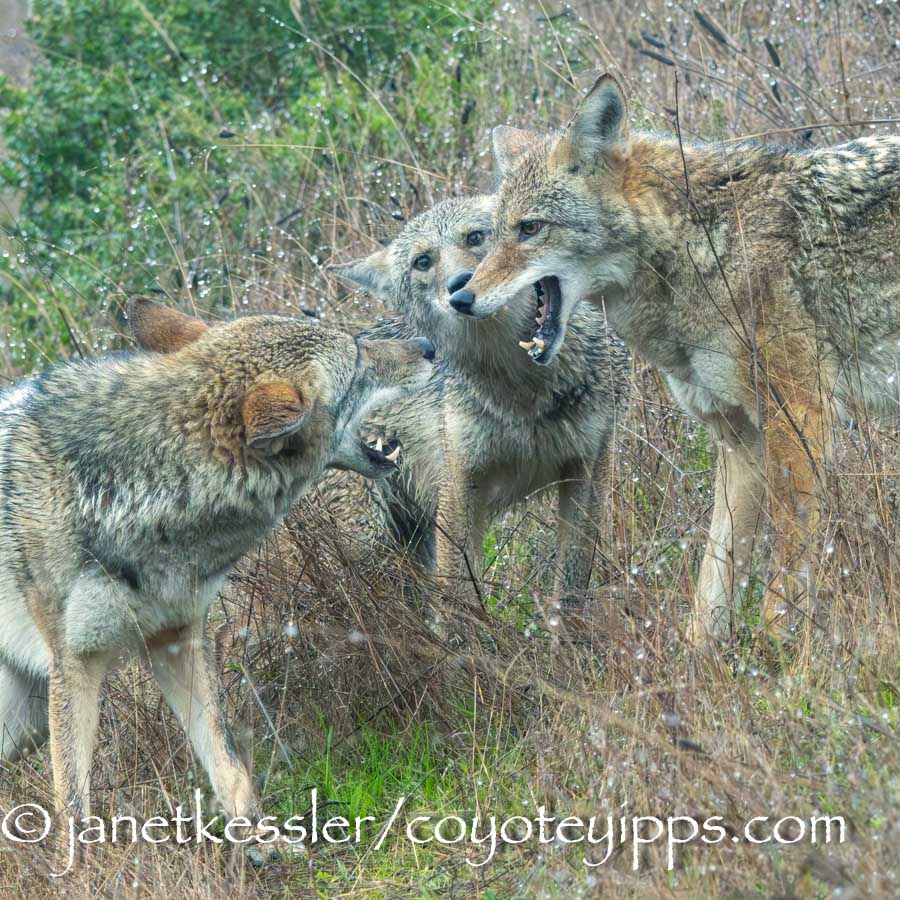
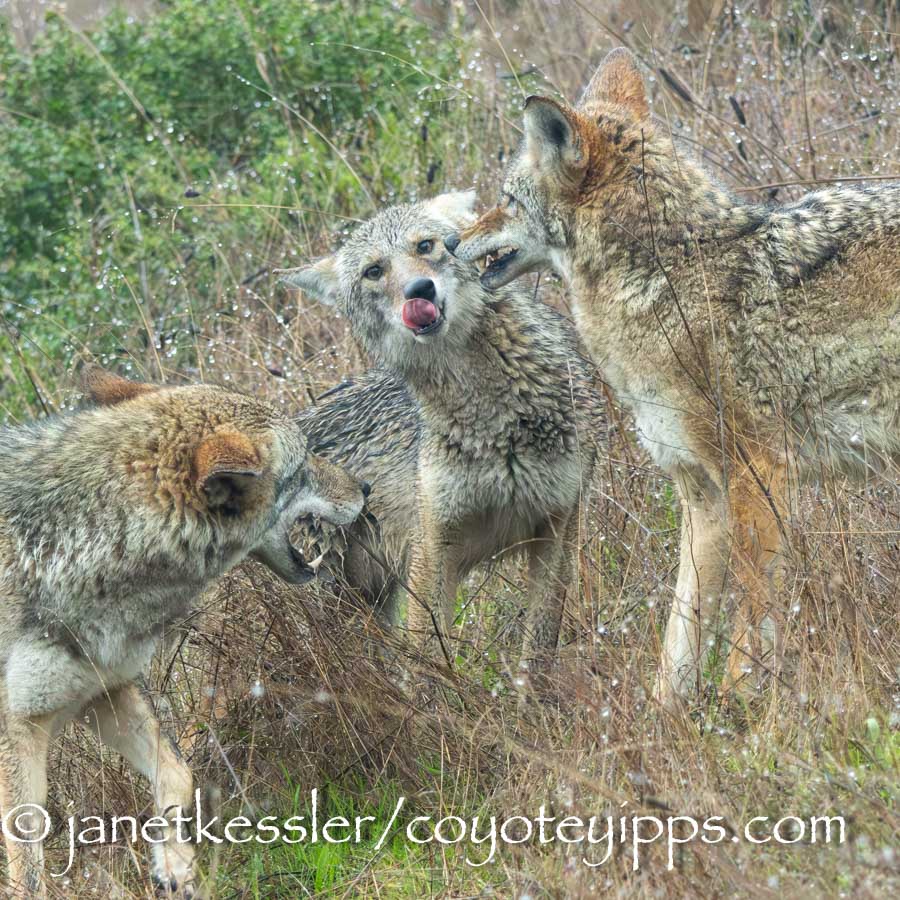
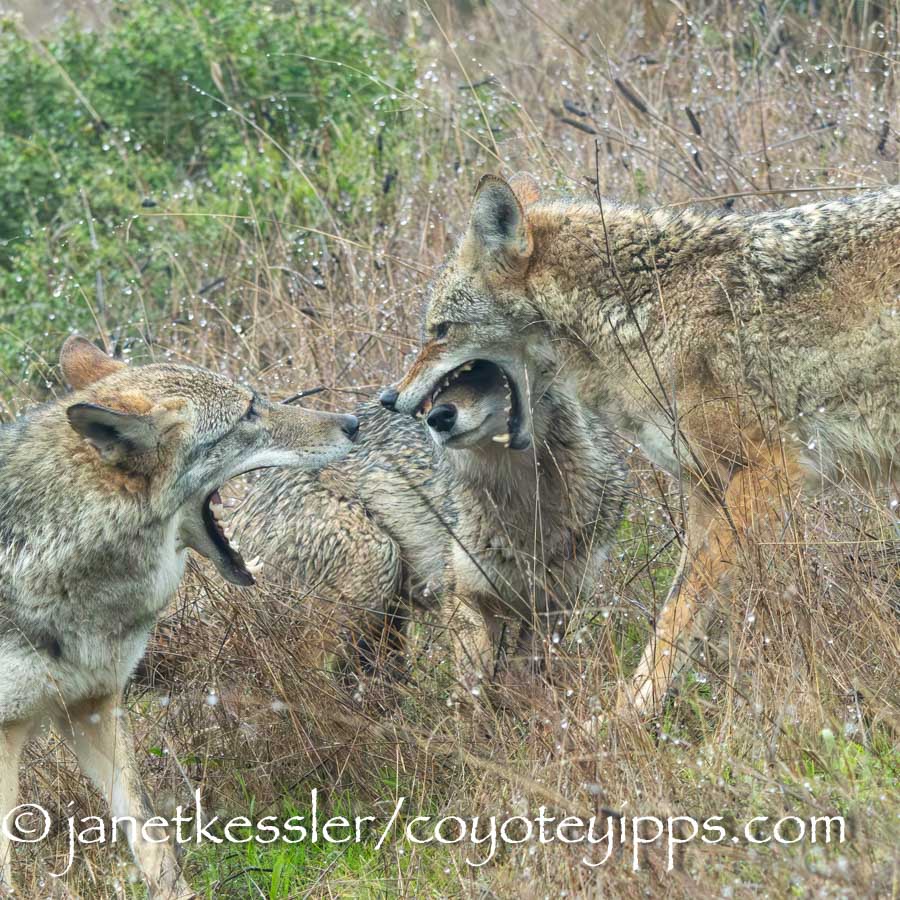
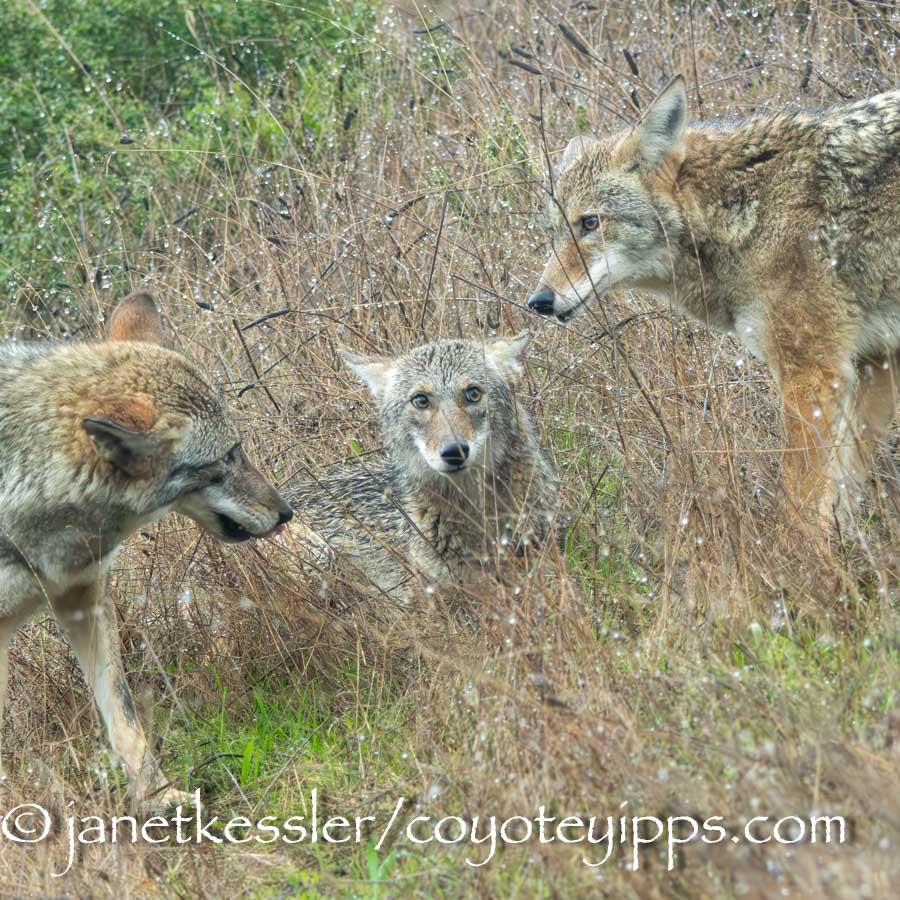
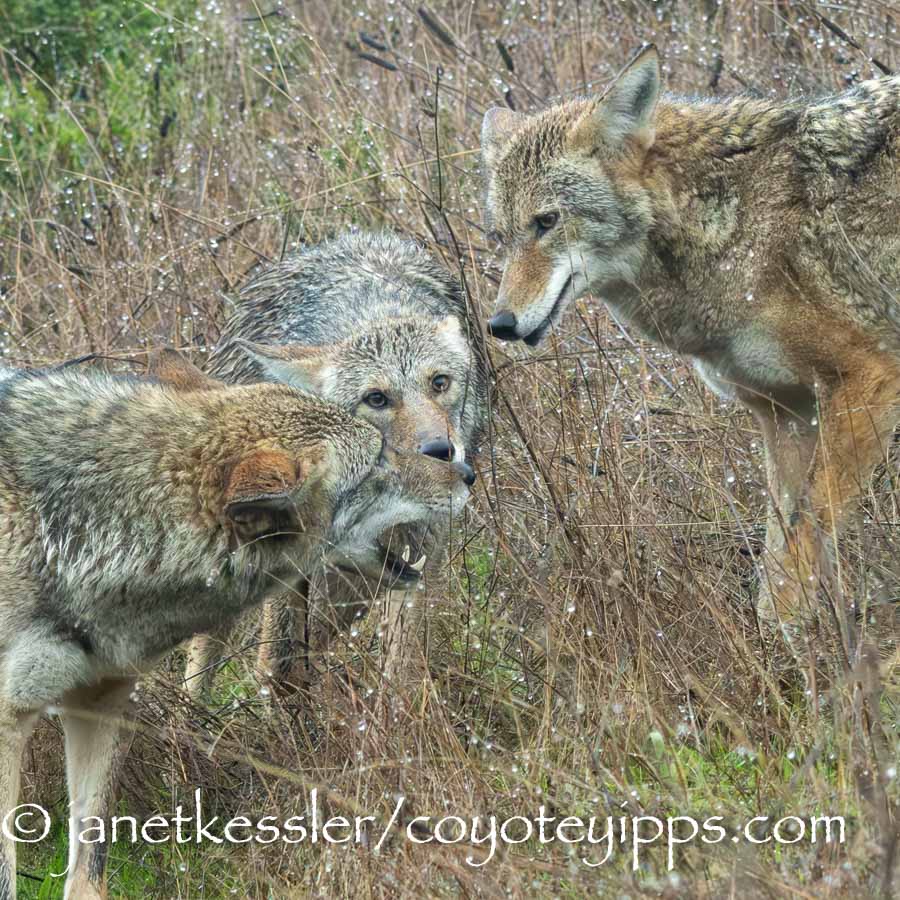
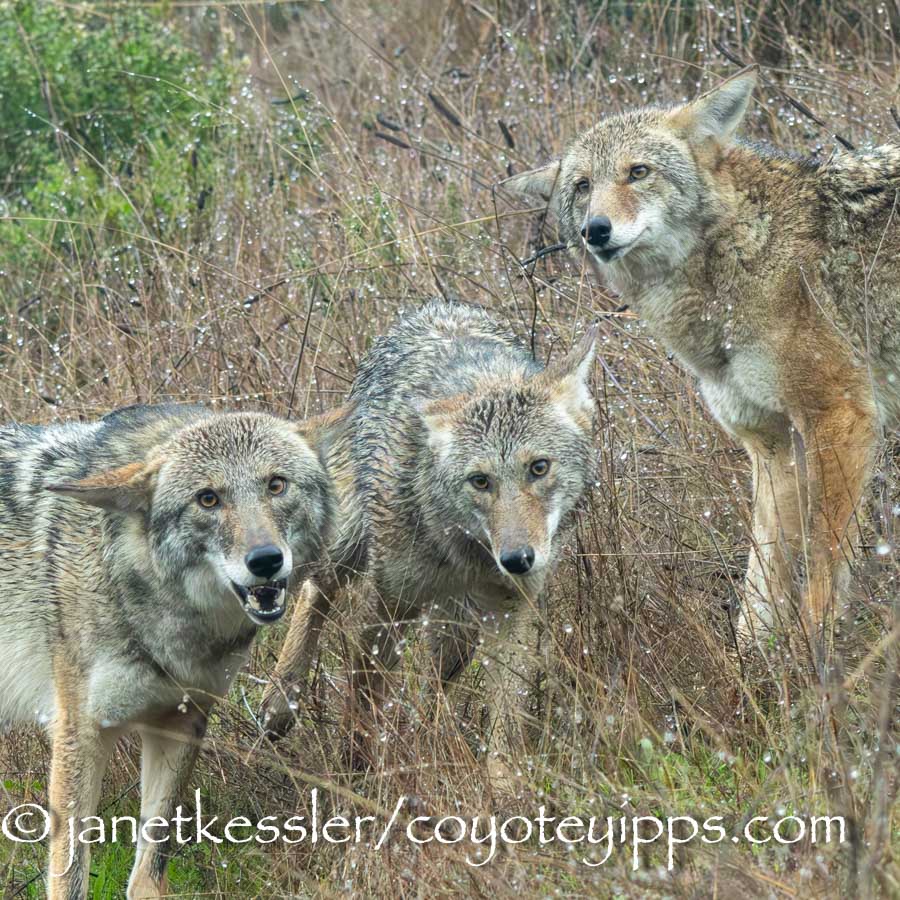
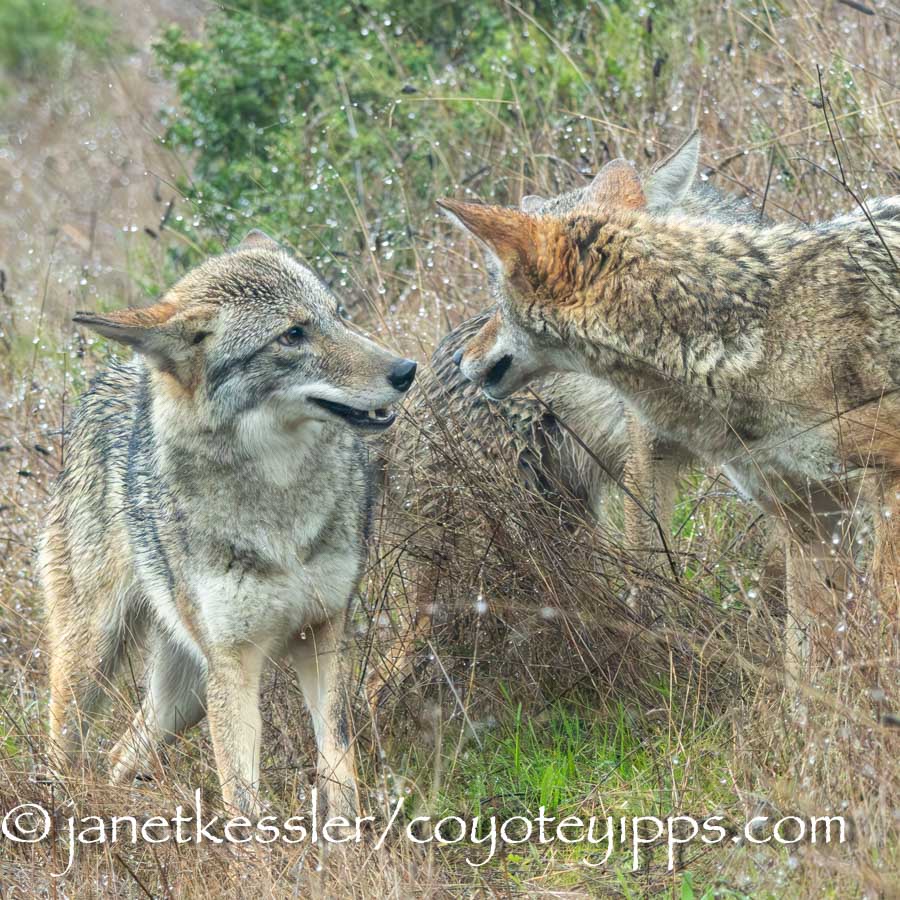
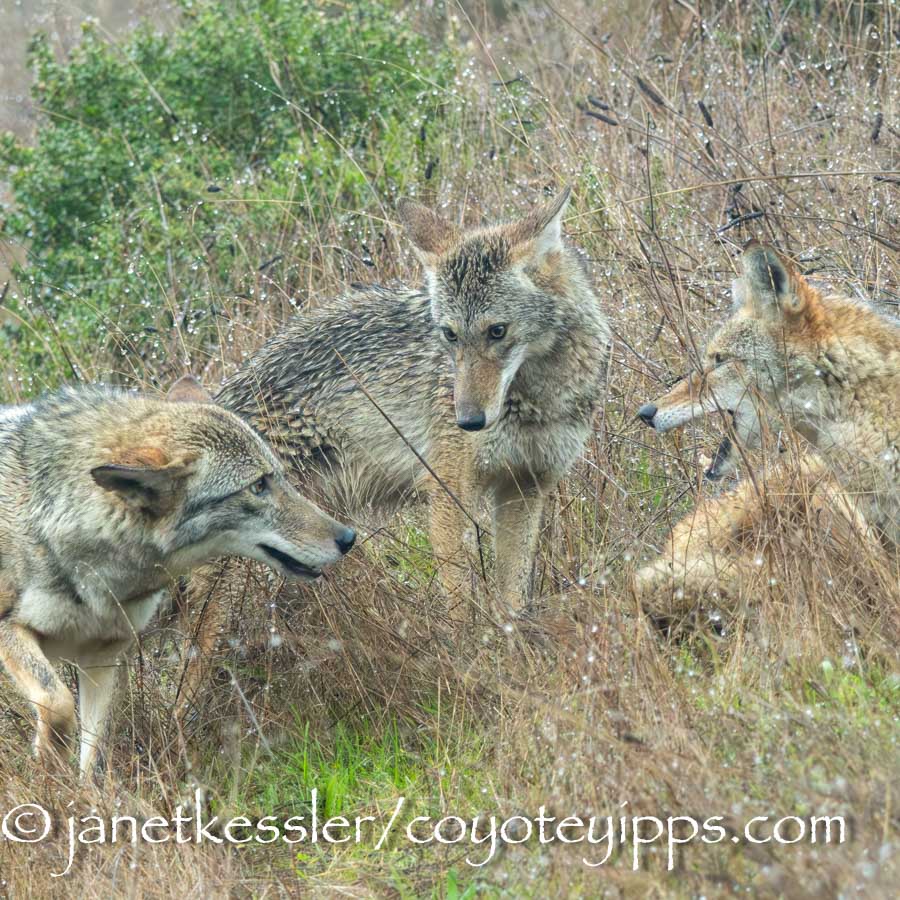
This series of photos shows Mom on the right letting Dad on the left know what she feels about what he’s doing. One of their youngsters is there, in the middle, looking on, and obviously anxious about how their “conversation” is going. Coyotes communicate constantly through eye-to-eye contact, facial expressions and body language. They are always aware of each other’s moods and intentions, and most of their communication is silent like this, though sometimes these might include quieter grunts and growls.
Top row: Dad had been lazily relaxing in the aftermath of a rain, when Mom approaches from the right. He’s taking it in stride, with his ears pulled back and focused eye-contact which shows he’s really listening. Notice how intently pup, in the middle, listens to it all and is upset about it’s intensity as shown by the anxiety in his face. He shows his nervousness by licking his lips.
Middle row left, pup is kept quiet and out of the conversation — or maybe even calmed down — by Mom who grabs his snout: this is usually a disciplinary move and reasserts her status and will over his. At this point, pup steps back but continues to be totally focused and absorbed in his parent’s “conversation”.
Bottom row: On the left is when they become aware of me: “Oh, hi over there!” But they’ve come to know me as a benign fixture in the distance, so their conversation resumes. It appears that Mom wanted Dad to get moving because she beckons him to follow and leads him away. Dad complies, and pup trotted along in back of them.
Another conversation that might interest you is this one: Coyote Conversation: An Example. These communications are very directed in their messages: they have a specific intent and planned outcome by the coyote delivering the message, and the message is understood absolutely by the recipient.
Besides eye-to-eye contact and all sorts of body language including physical arm pokes, coyotes also use smells to communicate: this is a whole different channel of communication that we “mere” humans do not have access to except in academic studies. In fact, in our terms, coyotes almost “see” with their noses. They produce and detect pheromones which convey all sorts of specific information, including territorial boundaries through urine scent marking, the presence of outsider coyotes including their meekness or boldness, reproductive status and gender, they can identify specific coyotes who have passed by even days beforehand, and they can smell injuries in each other. And, of course, much more.
In this photo here, it’s interesting to see how a parental communication to one youngster so thoroughly affects an onlooker pup. They, of course, can identify with the situation they are watching.
© All information and photos in my postings come from my own original and first-hand observations and documentation work which I am happy to share, with permission and with properly displayed credit: ©janetkessler/coyoteyipps.com.
Some Mom/Pup Interactions
23 Dec 2023 2 Comments
in mother coyote behavior, mother/pup learning, parenting
This morning the sirens began blaring, and Mama coyote began howling back at them. This type of response to sirens is an everyday occurrence with coyotes. Two of her 8-month-old male youngsters were close by. Youngsters are always happy to see Mom, and they are energized by anything she does, often taking their cue from her. They both ran excitedly in her direction after hearing her, but only one of them joined in the howling. The howling continued for a few moments as a duet and then petered out slowly before it stopped entirely.


I love watching these interactions which show the warp and woof of an interactive family life. And there were other interactions to be seen if you looked hard enough through the tall grasses which screened what was happening, but I was able to focus enough between those tall grass leaves to pick up a little of it.
Mom normally lets the pups do what they have to do to get along, and she stays out of their interactions. That is, unless and until they get too close to her. As they’ve gotten older, she’s become even more intolerant of boisterous or excessive activity that occurs close to her. These photos show her reacting to them as they begin interacting with each other: she seems to need to calm them down or to move the activity away from her. Her body-language message has to carry weight so that she’ll be listened to, so it is intense: she bares her teeth and wrinkles her nose threateningly to show her disgust.



Mom’s expressions relay her message to them: “Calm down around me!”
Coyote youngsters are always particularly ecstatic to see each other — it always looks as though they haven’t seen each other in weeks, even though it’s only been an hour since they crossed paths! Here, there were the usual wiggles and squiggles and licking and bumping that go along with greetings — all more than Mom wanted to put up with.






But pups have a need to interact visually and physically. Note their eye contact, one flops to the ground unchallengingly, there is grooming, and the guy on the ground jumps up to affectionately grab his brother’s ear.
Even after conveying her displeasure to the pups, Mom ended up distancing herself from them to accommodate the situation because their interactions continue. Pups, of course, HAVE to interact — the need to do so is uncontrollable!
Notice from the pup behavior in the photos that there is a rank between them. Their ranks are something they work out and choose between themselves. If these happen to be conflicting, well, there’s a conflicting relationship that may grow in intensity over time. In this case, the more submissive youngster, I’ll call him *Pow*, adoringly approached the more dominant *Bold*, keeping his body low, and extending affectionate muzzle touches, and even twisting himself so he could affectionately grab Bold’s ear! Bold returned the affection by grooming Pow.



THAT was too rowdy for Mom who decides to distance herself; the pups continue their affectionate interaction with her gone.
Coyote interactions are often short, yet they are intense and full of meaning. The interactions often are longer at the evening rendezvous.

© All information, maps, and photos in my postings come from my own original and first-hand documentation work [except where indicated] which I am happy to share, with permission and with properly displayed credit: ©janetkessler/coyoteyipps.com.
Lapis: Update
04 Dec 2023 6 Comments
in Blue eyes in coyotes, bonds, coyote behavior, siblings

You might recall that Lapis is the one-blue-eyed coyote pup I wrote about several months ago. I saw her a few days ago at almost 8 months of age: an update is in order. The change that struck hard is that the bright blue right eye of hers is no longer blue. The iris of that blue eye is now double the size of a regular eye — it almost looks like a glass eye. The iris is the colored structure in the front of the eye that regulates the amount of light that can enter the retina by controlling the size and diameter of the pupil. I don’t know how much light her eye lets in, but I would assume it is affected by the iris’s size. It seems obviously damaged or diseased, but it doesn’t seem to impact her activity.
Health issue in urban coyotes can develop at any time, but it’s sad when they develop early, as with this eye condition. I hope it’s not something that impacts her life too much. Last year pups in several of the coyote families developed neurological walking problems which they were either born with, or they developed very early after birth, possibly due to distemper. Other ailments I’ve encountered can be found HERE.
The day I saw Lapis, she was with one of her brothers and demanded that he interact with her: it was almost sparring behavior without the need to win. She’s comparatively petite compared to him but that didn’t stop her from engaging with him as an equal. He, on the other hand, I could tell, was careful not to overpower her. The roughhousing and wrestling he engages in with his brothers did not occur here.
I don’t know if he knows that something is wrong with her eye, but I would guess he does: coyotes are super aware of temperature differences, smells and visuals. For instance, they seem to know exactly where the hidden ticks are on each other. In another instance, I watched the mate of a young fellow sniff his broken ankle when that happened, and I knew that she knew it was injured and hurt him.
Below is a gallery of photos I took that day showing the sparring and interactions between these two siblings. The strong bond between them encompasses caring, playing, teasing, provoking, patience, and affection, in addition to warm companionship. Coyotes are hugely social and it is obvious that this relationship is important to both of them, and possibly is the highlight of their day. Things to notice: their communication through intense eye-to-eye contact, her jabbing him with her forepaws, affectionately biting his ear, biting his neck, grabbing his hindquarters, grabbing his head, putting her head over his shoulder, as she incited him to react to her. Notice he calmly allowed her to poke and flit as she pleased, and then gently and affectionately — almost protectively — reacted companionably more than anything else! [You can click on one of the photos to then scroll through them].


















Tetherball & Sleeping in a Flower Box: Thoughts about Some Human/Coyote Interactions
24 Nov 2023 6 Comments
in coyotes and human behavior, home alone






Fun with her found tetherball
Three postings back, on the third of this month, I wrote a post about the unusual frenzied behavior of a young loner male and his brief “tangential breaching”, if that’s the right wording, of the species-divide which is a cornerstone for coexistence between humans and coyotes in urban areas. I described him as *full of beans* more than anything else. The behavior appears to be related to what I’m describing in this posting.
This current posting — based on what I observed several years ago — is also about the overly exuberant, energetic behavior of a young loner, in this instance a female, who for a while also purposefully flirted with the accepted species-divide between wild coyotes and humans. With this young female, the behavior occurred time and again over a three year span. With few exceptions, this female did stay away from humans in terms of distance and not physically engaging — but at times it was as though she were “flaunting” it on some level. Easy coexistence is of course based on firmly maintaining a wall of separation. Note that “dogs and coyotes”, as opposed to “humans and coyotes”, breach the divide all the time: they constantly communicate visually and interact with threats and defenses — lunging, barking, chases and even nipping. This posting is about humans and coyotes, not dogs and coyotes.
We all know that coyotes are highly social: they normally mate for life and live in families. The few exceptions that I’ve seen include the death of a mate, some rare *divorces* thought they normally pair up again, and transients who have not been able to secure a territory or mate for themselves. Coyotes in families interact and communicate constantly with one another. But what if such interaction is out of reach for one of them because there is no bonded companion or family around and therefore no opportunity to socialize with any members of their own species — this is a question I’ve asked myself to try and explain her behavior. It seems that a loner under these circumstances for an extended length of time — in her case it was three years — might seek it from another species, even if only psychologically and even if at a distance — i.e., virtually? It appeared to me, after many observations, that this loner coyote was starved for social interaction: and she appears to have picked humans (often with their dogs) for connecting with in this way. Interestingly, once she found a mate, she dropped this behavior absolutely and totally, which supports my speculated explanation.
Coyotes by nature are secretive in their behaviors and wary enough of us humans to avoid us almost always. However, over time in an urban environment, with constant human presence, they often begin to ignore us as benign beings rather than as “risks to be avoided”. And we humans normally think of their proximity to us as a “risk” to ourselves, so we label it as “brazen” or “bold”. Some people consider simply seeing coyotes in an urban setting as unacceptable and risky. In ranching communities, seeing coyotes on ranching properties is cause for killing them. So there’s avoidance on both sides which is very mutual. But over time, we, too, learn that they are pretty benign and we begin to accept them at closer range than we used to, especially if we don’t have a dog with us.
The young female’s behavior consisted of regularly sitting on a high knoll in plain view during daylight hours at the height of dog/human activity which she was there to watch, and of course, she in turn was watched back: there appeared to be mutual fascination between her and the human world. She seemed to know that she was being admired — coyotes, like the rest of us, can sense this sort of thing. She would then suddenly get excited and “perform” as in the video. She could easily have remained quietly observing or retreated to the bushes where she would not have been visible by anyone, but she chose not to do so. She chose to draw attention to herself, creating a visual interaction of sorts.
Coyotes feel they must respond to dogs chasing them or even passing through their territories. Hunting is another must which often takes place in the visual presence of humans, though normally at some distance from us and predominantly during the darker hours. On the other hand, in the two instances I’ve described in this and the previous posting, the flirtingly marginal interactions or visual engagements of coyotes with humans were purely a matter of choice on their part — no need was involved.
Each coyote is an individual with a unique personality. I don’t know if individual characteristics contributed to the behavior: some coyotes tend to be innately much more gregarious while others are more shy — you can see this in their interactions with each other, and in their reactions to approaching people or dogs. Although humans deliberately feeding her or even just leaving out food, might have initiated a gradual suppression of her natural wariness for awhile, neither she nor the male in my previous post were at all approaching humans for food — that is a separate type of behavior..
On the other side of the spectrum of this hyperactive attempt at interaction and attention-seeking are the coyotes who remain relaxed within close proximity of calm human presence, unobtrusively, out-of-the-way, quietly and without any fanfare: I’ve seen this in areas where no dogs are around. They actually aren’t interacting with humans, rather, they are simply there, mostly ignoring people only 20 feet away — a nod of acceptance might be exchanged, but that’s it — they aren’t seeking attention or performing. This happens in some community gardens where coyotes have been seen napping regularly in some of the planter boxes, in spite of there being plenty of gardeners close by working their plots. The gardeners respect them and leave them alone. Again, the one issue has been when dogs — who are not allowed in the gardens but enter anyway — come through and go after them. So here, coexistence in a very small space is not at all a problem for anyone, coyote or human, unless dogs appear.
With an ever-present and large urban human community, it seems logical that intelligent and curious coyotes might explore options beyond strict avoidance of humans. Maybe the examples I have given are simply manifestations of this.


Napping in a planter box with a beehive of gardeners quietly at work close by
© All information, maps, and photos in my postings come from my own original and first-hand documentation work [except where indicated] which I am happy to share, with permission and with properly displayed credit: ©janetkessler/coyoteyipps.com. [67/9118]
Interloper
10 Nov 2023 Leave a comment
in interloper

Aging. From what I’ve seen in the urban environment of San Francisco, coyotes who reach 11 and 12 years of age are at the upper limit of their lifespans. Compare this to their lifespan in captivity which is about 14 to 16 years, or to their lifespan in the wild-wild, which I’m told is only 3 to 5 years. By the time they are old they may be on a second mate who would be younger than they are. They will have gained greying brows and a more worn look to their faces. Bones and muscles become worn out, so it takes them longer to get up, and as they get up you can see the stiffness and some unsteadiness that wasn’t there before, until they start moving: it’s harder for me to detect an aging coyote when they are moving. Fur, of course, hides a lot of the wear and tear they have accumulated, the same way that clothing hides it in humans.
Claimed territories. Some of these oldsters remain on their claimed territories right until the very end of their lives and then the territory is acquired by default by their offspring and/or mates: these territories can be owned by the same genetic families over many generations. On the other hand, in other territorial situations, the death of a mate might contribute to an inability for the surviving mate to hold on to a territory. Aging in itself is a weakening factor, leading an oldster to abandon his/her territory voluntarily. I’ve wondered if abandoning a territory might also be related to the end of a coyote’s ability to reproduce: this is pure conjecture on my part — I have no proof of this, it just crossed my mind. Territorial intruders who appear off and on in all territories are normally fended off fairly easily by a mated pair. However, without a mate and with growing weakness due to age or possibly illness, a territorial confrontation, or even a battle could ensue and the weaker claimants would be forced to leave. This happened at the Presidio in 2019.
What happens to the coyotes who leave or have been driven out from their territories? I seldom see them again, or if I do, it’s only briefly before they are gone forever. Because I never see them again, I am unaware of how their lives continue, if indeed they do continue. Their old territories become occupied by the newcomers and life goes on.
Interlopers. But sometimes, the displaced coyote who once owned a territory becomes an interloper who I’ve been able to follow, even if only sporadically. An interloper is a coyote who has no territory to call his own anymore, but who lives in the interstices between other claimed territories. Unless you know the individual coyote, you wouldn’t know his situation. The older or more injury-compromised these coyotes are, the less likely that they can take and hold onto a new territory. Such a coyote is Ash.
Before I go on with Ash, I want to mention that at the other end of the life cycle, dispersing yearlings all become interlopers until they find their own territories. Both yearling loners and yearlings who have found mates along the way and are still looking for territories are in this situation. They live and roam quietly on the fringes and interstices between territories and pass through claimed territories as quickly and unobtrusively as possible, assessing mostly through smells what the situation is in these territories: through smell, they can tell what coyotes have been around and how regularly they’ve been around and probably their reproductive condition and much more: they would be able to tell right off if one of the alphas is no longer around. If they find a vacant niche, moving in can be easy, but if all territories are taken, if conditions are right, they might actually fight for the territory. Those that don’t find territories after dispersing here in San Francisco appear to move south and out of the city in their continued search for a home, and along the way many are killed by cars [per a three-year, radio-collar study by the Presidio from 2015].
You’ll recall my posting about Ash: https://coyoteyipps.com/2023/08/23/ash-aging-injury-decline/. He left his territory because of an injury. I don’t know how he got the injury, and I don’t know what happened to his mate, but another coyote pair are now the alphas in the territory he left behind — and it appears to be a son of his but I’m not absolutely sure about this. As I wrote in that previous posting about Ash, I didn’t think Ash was going to last very long without his territory because he was getting along in years and had an extremely compromising injury which turned him into a *tripod* coyote, but he has proven me wrong. Since I wrote that post, he has appeared in various spots around the south and center part of the city, and I actually saw him in my own neighborhood at 5:30 a couple of mornings ago. He has been without a territory for well over a year now.
In fact, I’m wondering if the city’s interloper population might be growing — if there are more like him.
A couple of weeks ago I wrote about another interloper, a strapping young fellow, who intruded into a claimed territory: https://coyoteyipps.com/2023/10/22/intruder-dynamics-at-work/. This is a coyote I didn’t recognize, but his youth made me think that he was dispersing and looking for both a territory and a mate. I watched the fellow as he sat very still and listened to the howling chorus of the resident family. That must have summed up the situation for him because he left and never came back.
Two years ago I watched an interloper move into a territory where the alpha male had died of old age. He sired a litter, but apparently there were compatibility issues with the remaining alpha female there — it was very obvious she didn’t like him. When the pups were just four months old, that fellow left. The next year, he was the alpha in another territory, this time remaining for a full year. But after a year, he is now gone and I’ve not seen him since then. I can only reflect on the huge difference between this fellow and the family who has been tied to their territory for multiple generations.
And I’ve written about what I called a *Gypsy* coyote pair that actually picked up and moved across the city a couple of times, each time claiming and becoming the owners of the new territory they had moved to for several years where they raised their pups. Eventually this coyote pair ended up divorcing: yes, that also happens.
Who, in the way of coyotes, gets a territory, and who is excluded? Within urban areas, as I suppose within any area, coyotes gain advantages over conspecifics based on luck, being in the right place at the right time, physical size or strength, force of personality, ties to the family territory they were born into (generational territories), intelligence and a savvy nature when it comes to dealing with other coyotes — the same kind of the advantages humans have in moving forward with their lives and gaining choice territories. Less advantaged conspecifics are left with less advantageous territories or no territories. And competitors such as foxes have been pushed to the periphery of the city. Nature is not fair.
Meanwhile, back at Ash’s old homestead — a territory where he had been the alpha for years, where he had been through a couple of mates and raised many litters — the territory is now owned by another alpha pair who had a litter this year — the alpha male appears to be Ash’s son, though I need to confirm this. Of interest — and I bring this up because of the very different situations each coyote finds him/herself in — I notice that there’s a third coyote, a yearling, who appears to have been adopted into the family. Yes, adoptions take place, especially of injured or weak youngsters: I usually see it for under a month when a youngster is dispersing, but could it last longer? This yearling has been allowed into the territory, but does not hang around the territorial claimants as far as I have seen: my prediction is that he will soon move on: he’ll become an interloper himself. https://www.instagram.com/p/Cn-havfPAwG/. From what I’ve seen, owning a territory confers much more survivability on coyotes.
So, every coyote and coyote family situation I’ve observed is different — no different from the way it is in humans. I’m told this individuality is due to our being generalists and therefore having amazing adaptability: we and they are not meant to survive in just one type of environmental niche or situation, as opposed to animal specialists who require unique situations and habitats for survival. This adaptability allows different potential traits to be developed in each of us as needed or sometimes as desired. So all generalizations regarding coyotes need to be qualified with many exceptions. The situations I describe here are ones I have seen; I’m sure there are many more variations. For more, you can type into the blog search box: territories, intruders, interlopers, dispersals.
© All information, maps, and photos in my postings come from my own original and first-hand documentation work (except where indicated) which I am happy to share, with permission and with properly displayed credit: ©janetkessler/coyoteyipps.com.
Intruder Dynamics at Work
22 Oct 2023 2 Comments
in dispersion in progress, intruder
The start of any of my observation sessions involves always identifying WHO the coyote is that I’m watching. I use their faces to identify them because their coats not only change over the seasons as they shed and grow, but they also appear different under different lighting and weather conditions. Once I have their identity down, I of course can relate any behaviors I see to what I already know about the coyote.
To begin with, the coyote I began watching was facing away so I couldn’t positively identify him when I started. From his general shape I initially assumed he was the alpha male of the family that lived in this location. Several times he gave me a profile view, but that resulted in more questions than answers. And then I saw his face straight on and his light eyes: no, this was definitely not one of the coyotes who lived here — it was an intruder!


The coyote we saw faced away from us. When he finally looked over at us, we could see that this indeed was an intruder, not part of the resident family.
Coyotes are allowed to briefly pass through claimed territories without incident if they do so quickly, without challenging the resident coyotes. Intruders have been rare in this particular territory. Maybe there have been as many as five in this one territory in the entire time I’ve been observing — over the past 16 years — so it was actually special and exciting to see him there! A friend of mine and I watched intently. The coyote remained in the one location we had found him, standing most of the time, and then finally sitting down, always facing away from us.
While he sat there, the resident family began to howl. Were they aware of him? I don’t really know if the howling was related to him: it was not particularly intense or threatening, as far as I could hear. I took a short blurry video and have included that so that you can hear the family vocalizations and the intruder’s lack of vocal response. Although he remained quiet and did not respond to their howls, he was picking up as many signals as he could about the situation, and you can be sure that he was indeed reacting internally. The video is blurry because the camera automatically focused on the long surrounding grasses, but the important point is to hear the vocalizations, and see that this outsider listened intently. If he were part of the family he most likely would have responded. When the howling stopped, he slowly got up and began moving away from the area.



Walking away while continually looking over his shoulder to where the howling had come from.
We followed him for a short distance as he headed slowly, deliberately and decisively out of the park, but then we turned back — we didn’t want to interfere at all with his exit, we already knew he was headed out. We returned to where we had originally been, and within minutes both the resident alpha male and the alpha female rushed over close to where that intruder had been. And they too, faced the direction where they had been howling from, never actually going to the intruder’s exact spot. I suppose they will discover and explore that later. Probably their strong olfactory equipment had already let them know that the intruder had departed. They did not try to pursue him: it’s to coyote’s benefit not to engage in a fight which might injure them enough to prevent survival.



Mom and Dad rush over (top two photos) and remained in an anxious state of alert (bottom photo). Possibly they were keeping their eyes on where they knew the pups were.
After the very palpable bulk of tension had subsided, the alpha male wandered to the family’s rendezvous spot, but a youngster there must have sensed the tension because he remained on his back even though his dad was a substantial distance away. I suppose the family will be on higher alert for the next little while.
I’ve seen a number of intruders throughout San Francisco in the 16+ years I’ve been observing, and in each, something what I saw was a little different. I’ve seen an intruder simply turn and leave shortly after coming into a foreign territory and finding out what the situation was by sniffing — the resident family, as far as I could tell, did not even know he was there, though they probably sniffed his presence at a later time. And I’ve also watched territorial claimants hotly pursue intruders and even viciously attack in their effort to get that intruder to leave.
This time, we heard an intruder react to territorial vocalizations by quietly leaving, and the family react anxiously. Maybe the family saw him leave and knew he wouldn’t be coming back — there’s no reason for a fight here. Fighting happens only when one side won’t back down: you might recall Scout’s plight [search *Scout* if you are interested]. Other examples of intrusions can be found by typing in *intruder* into the blog’s search box.

The Intruder today looked like he was 2 or 3 years old — he would have been looking for a territory and a mate. Just like for humans, life’s various transitions for some coyotes are smooth and seamless, and for others there is much more effort and uncertainty as they search for openings and opportunities to improve their situations, and ultimately find themselves. I think this is a good way to look at their lives: as very parallel to our own.
Another Rendezvous
01 Oct 2023 4 Comments
in grooming, rendez vous
In case you haven’t seen one, here is a family rendezvous that consists almost entirely of mutual grooming.
The family here includes Mom, Dad, a one-year-old yearling, and a two-year-old yearling. I’ve seen the young pups born this year, but they have not been part of the nightly rendezvous yet in this location because they’ve been raised some distance away due to disruptive dogs here: so the rendezvous at this location consists only of the adults to date. The adults in most families sleep during daylight hours away from the pups. The pups would be five months old in this video — they will have attained a pretty good size by now. After the rendezvous here, these adults then go trekking into the distance beyond the safety of this park where they meet up with the youngsters. Please remember that each family is different — this situation with pups ensconced further away is different from what I normally see.
The reason I’ve posted this video is to show how much grooming is going on between each of the individuals: this amount of grooming, in fact, is quite normal. I’ve broken it down in italics below if you want to know who is grooming whom. Basically, the yearlings groom each other, everyone grooms Mom. . . . . Knowing who is who is unnecessary for appreciating the mutual grooming, but If you want to know who is who, here is the breakdown.
Video begins with two year old son to the left; one year old daughter, Dad, and then Mom to the right: Son begins grooming Sister and then both youngsters groom Dad with Daughter moving over to the right at about :42.
At :52 Son and Daughter groom Dad with mom in the background. At about 1:00 Daughter begins grooming Mom.
At 1:05 Son reaches between Mom and Dad to groom Daughter on the right as Daughter grooms Mom and Dad looks at us.
At 1:34 Son stops to scratch himself and Daughter continues to groom Mom and then grooms Dad as the video ends.
Grooming serves multiple purposes: to get rid of bugs, it confirm ranks and it strengthen bonds. The grooming went on for about 20 minutes — this is just a short section of that session over a month ago (8/25)
Scat is Where It’s At, by Walkaboutlou
20 Sep 2023 Leave a comment
in coyote scat, scat reveals diet

This coyote isn’t raiding sheep, lamb, or calves.
It’s been at the berries, rodents and grasshoppers. And so has its family.
[I responded asking if this could be sent to the ranchers who were complaining]
This has been done and they followed up with trail cams in different spots. (Not a light decision..the bears often damage the cameras. Expensive.)
They did find a coyote with prey…a feral cat. (That’s another plus…for the local songbirds and quail) No coyote seen outside sheep pastures…but two neighbor dogs were. (From over mile away and both times between 10 pm-1am. )
So scat scouting really is needed to confirm coyote predation or to pin point what really is going on.
In this case, dogs freed at night were the prime suspects, not the local coyote pair.
Lou


